








































As we wind down 2022 and look ahead to 2023, WhatTheyThink’s thought leaders weigh in on their industry predictions.
David ZwangThis was the year the globe opened back up again, although for labels and packaging it never really closed. In fact, looking back and even today, converters, equipment manufacturers and suppliers are a bit giddy about their growth rates.
Next year will probably see similar growth, regardless of the ongoing war in eastern Europe and inflationary effects in many countries. The value growth will be attributed to the increase in higher-cost digital production driven by consumer market shifts and resultant shorter runs across the packaging landscape. Volume increases will be attributed to the increased purchasing power of consumers.
Pressure continues to increase on the textiles and apparel industry to transform itself into a more sustainable model. This reaches from sources of feedstocks – whether bio-based or fossil fuel based – through to processing feedstocks into fibers, fair treatment of workers who spin, weave, sew or otherwise contribute to the final product, and to brands to create full lifecycle calculations of their contributions to climate change.
Progress is slow; still too much emphasis on over-consumption and fast fashion. But suppliers to the industry are busily improving digital printing technologies, developing more sustainable fibers and finding ways to reduce chemical use.
In 2023 and beyond, the key to achieving any of these goals is consumer pressure. Some brands are taking responsibility, but others will likely do very little unless revenues fall dramatically.

In the commercial print production segment, we are hearing about healthy placements numbers from offset and digital print manufacturers. New product developments continue to focus on being easier to operate (by less skilled operators) and feature more automation features. On the production inkjet front there continues to be advancements in productivity, quality and media support. ●




PRODUCTION EDITOR & MANAGER
Amy Hahn amy@whattheythink.com
EDITOR Jessica Taylor jessica@whattheythink.com
MANAGING EDITOR Richard Romano richard@whattheythink.com
SENIOR EDITOR Cary Sherburne cary@whattheythink.com
BUSINESS DEVELOPMENT
Stephanie Papp stephanie@whattheythink.com 6 02-639-0530
BUSINESS DEVELOPMENT
Adam Goldman agoldman@whattheythink.com 312-940-7504

PRESIDENT Eric Vessels eric@whattheythink.com 740-417-3333
COO Adam Dewitz adam@whattheythink.com
Kevin Abergel
Lou Caron Dave Fellman
Joanne Gore Chuck Gerardi
Steve Johnson Jennifer Matt Lois Ritarossi Frank Romano Ralf Schlozer
CREATIVE SERVICES
Heidi Tolliver-Walker Trish Witkowski Warren Werbitt Danielle Yuthas David Zwang
THE GRAYING OF WIDE FORMAT Where we stand in 2022/2023
By Richard Romano
TIME TO THRIVE Digital will continue to grow. By David Zwang



NEW SOFTWARE TOOLS The gateway to business transformation. By Jennifer Matt

SUSTAINABILITY IS KEY BUT PROGRESS IS SLOW Some brands are all in. By Cary Sherburne
YOU HAVE DIGITAL EMBELLISHMENT Now how do you market it?
By Kevin Abergel

Bobbi Burow, CreativityTank LLC bobbi.burow@gmail.com ARTICLE


For subscription info, change of address, and other updates email help@whattheythink.com
WhatTheyThink (ISSN 2642-3189) (USPS 500-850) Volume 45, Number 6 is published six times per year in January/February, March/April, May/June, July/August, September/October, November/December by WTT Media, Inc., at 2038 Ford Parkway #218, Saint Paul, MN 55116. Periodicals postage paid at Saint Paul, MN and additional mailing offices. POSTMASTER: Send address changes to WhatTheyThink, 2038 Ford Parkway #218, Saint Paul, MN 55116. Subscriptions: Individual subscriptions are available without charge in the U.S. to qualified subscribers. Publisher reserves the right to reject non-qualified subscriptions. Annual subscription prices in the U.S.A $95; Canada $125 USD; all other countries $150 USD. Printed in the USA. Copyright © 2020 WTT Media, Inc. All rights reserved. No part of this publication may be reproduced or transmitted in any form or by any means, electronic or mechanical, including photocopy, recordings or any information storage or retrieval system, without permission. WTT Media Inc. does not assume and hereby disclaims any liability to any person or company for any loss or damage caused by errors or omissions in the material herein, regardless of causation. The views and opinions in the articles herein are not those of the publishers, unless indicated. The publishers do not warrant, either expressly or by implication, the factual accuracy of the articles herein, or of any views or opinions offered by the authors of said articles.
A PSP'S GUIDE TO CHOOSING MARKETING TECHNOLOGY How to navigate the ever-expanding MarTech landscape.
By Joanne Gore

DIVE RIGHT IN Interactive print is mainstream. By Heidi Tolliver-Walker
OFFSET LITHO IS FAR FROM DEAD Realism goes hand-in-hand with optimism as sheetfed offset OEMs survey the state of their marketplace.
By Patrick Henry






In case you have been trapped in an underwater pyramid for the past few years, here’s the story so far:
2020
● Wide format was a saving grace during the pandemic.
● The “pivot” to safety signage, et al.
● Shutdown of key verticals (events, travel)
2021
● We’re ba-a-a-ck!
● Rebuilding business during recovery
● Occasional variant-related bumps
2022
● Expanding capabilities and addressing challenges new and old
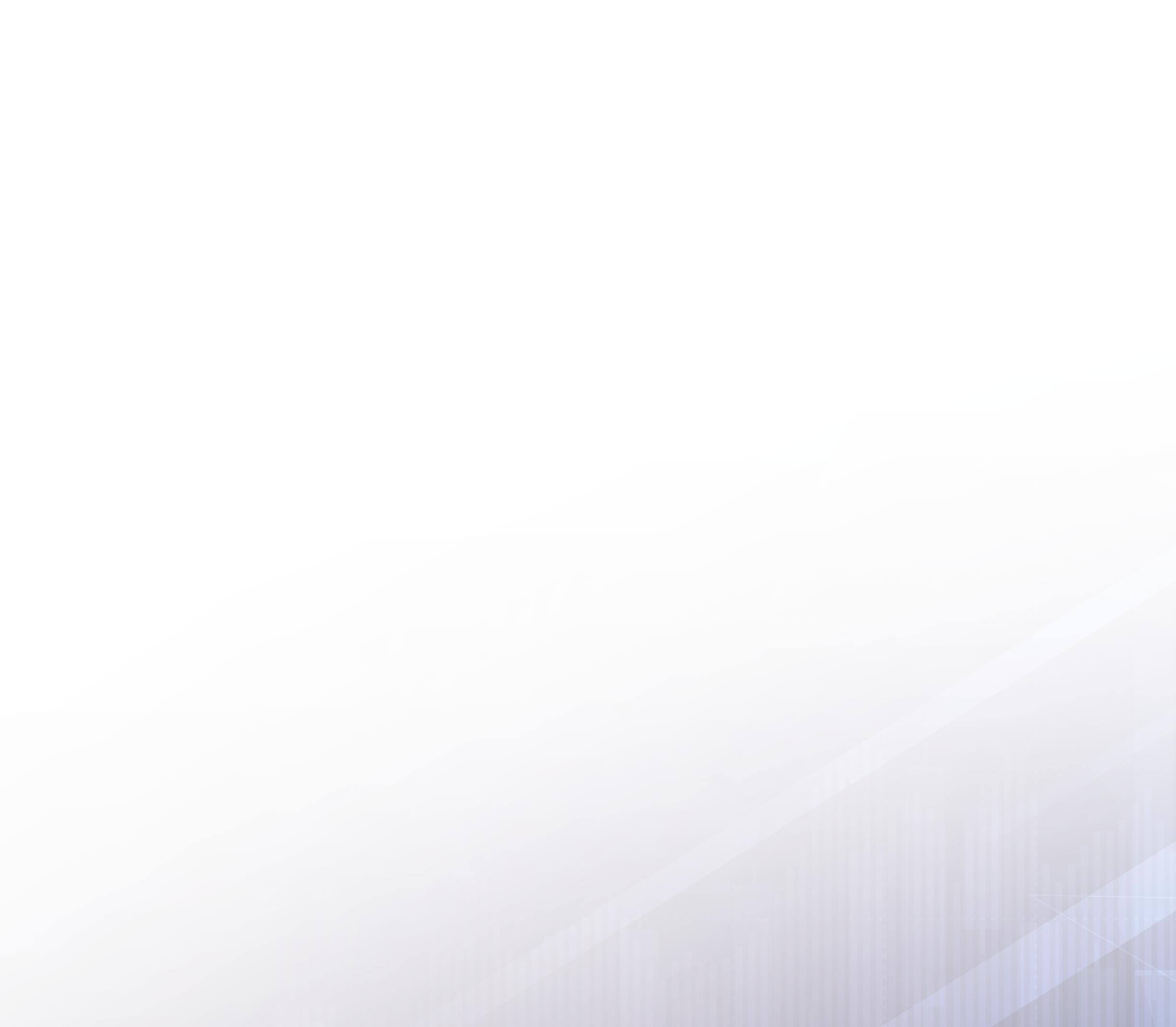
● Flatbed printer acquisition growing; expands range of projects
● True automation is finally coming to wide format.
There’s no denying that wide format is a mature sector of the printing industry, and perhaps most symbolic of where things stand today is the news last spring that Agfa had acquired Inca Digital.
Back in 2001, Inca’s Eagle was one of the first commercially successful UV flatbeds and really helped kick off that product category
Agfa is no slouch itself when it comes to flat beds, but one of the things that appealed to Agfa was Inca’s developments in single-pass printing for packaging, which is now the high-potential-growth sector of the industry—kind of where wide format was a decade ago.
In response, Fujifilm, a partner of Inca that had distributed its high-end Onset presses, announced
a partnership with Spanish industrial print manufacturer Barberán to develop a single-pass wideformat printer capable of printing at speeds up to 6,000 square meters per hour.
We’ve mostly heard of single-pass inkjet in the context of corrugated printing, but the Fujifilm announcement specifically addressed single-pass inkjet for sign and display graphics producers.
If single-pass inkjet could reach the quality level demanded by display graphics customers, the gain in speed could be quite the productivity boon. Sure, wide-format productivity isn’t always about speed, but it helps, and we’ll be interested to see what the Fujifilm/Barberán comes out with.
So, indeed, packaging is the next great adventure for the industry; if you look at the pace of technology advancements, the number of packagingcentric shows, and the sheer number of packagingrelated press releases, that is certainly the sector of the industry gaining the most attention—again, kind of where wide format had been 10 or 15 years ago.
In the past couple of years, our annual Business Outlook surveys have found that the commercial print migration to wide format is largely over, and we find that about 30% of the industry are what we could call “never wides.” (See Figure 1)

Sign shops, meanwhile, remain focused on “tradi tional” constructed signage, like channel letters, mon ument signs, complex construc tion/installation projects, etc.— stuff that is far more than print ing on something—tending to prefer to, as Dr. Joe Webb used to say, stick to their knitting.
At the same time, there has been some convergence, at least among the franchises.
Alliance Franchise Brands— which has both commercial print and sign franchises—has created 33 Allegra/Image360 dual-brand locations to handle commercial printing as well as signage needs.
So we had been seeing the line between a print business and a sign shop continuing to blur—and, tellingly, a couple of years ago, the National Print Owners Association changed its name to the National Print & Sign Owners Association—but in the post-pandemic era, the line between commercial and wide format is starting to sharpen a bit.
As Figure 2 shows, adding wide-format printing continues to cool as a perceived sales opportunity. (As I write this, our “Fall 2022” is in the field, and based on early preliminary results, wide format as a sales opportunity is down to 8%.)
Another way of gauging this is by seeing if anyone is buying new equipment.
Figure 3 doesn’t indicate whether wide-format printer investments reflect an initial foray into wide format or if they’ve been in it for a while, but there is an uptick in 2022 in all three catego ries of printer, based on our preliminary results— especially flatbeds.
Manufacturers have really been building out their flatbed portfolios in the past couple of years, so there are more choices in the entry-level and middle range categories. Therefore, the barriers to entry to flatbed UV printing have been coming down, which could be driving some renewed interest in shops getting into the wide-format market from scratch, or roll-fed shops taking the plunge and adding a flatbed to expand the range of applications they can produce. We’ll still have to wait to see what the final
oft-ignored aspect of automation.
It took a while for web-to-print to come to wide-format, but it really took off during the pandemic.
■ wide-format color printer (34 in.+) solvent/ecosolvent (like Epson, Roland)
■ wide-format color printer (24 in.+) latex rollfed or flatbed (like HP Latex)
■ wide-format color printer (24 in.+) flatbed UV (like EFI VUTEK, Canon Océ Arizona)
The key to making web-toprint work is having standardized templated products, which also lend themselves to an automated approach to production. This doesn’t preclude shops doing highly creative, bespoke and one-off projects—which can command a premium—but having a steady stream of highly automated “bread and butter” work coming in can free up design and production staff to devote more time and creativity to heavily customized jobs.
On the hardware end, robot ics are now turning up on more and more systems to automatically load/unload flatbed printers and/or cutting tables. It’s not inconceivable that we are not far away from shops being able to replace an entire shift of humans with robotics.
New Business Formation
I know I mention this all the time, but last year, The Economist had the headline, “New business formation in America goes bezonkers.”
results of the 2022 survey are, but based on this pre liminary data—and the sales opportunity question— it looks like these investments are by shops that are already producing wide-format graphics and are adding capacity, upgrading their current equipment, and/or adding new capabilities.

As we head into 2023, what are the top trends for wide format?
Automation
Automation—real automation—is finally coming to wide format. Automation used to just mean “nesting optimization,” but web-to-print portals allow customers to get quotes, submit jobs or purchase standardized templated products—an
New business applications reported by the Census Bureau were almost quite literally off the chart (like many of our y-axis chart issues in 2020 and 2021) and while business formation has become a bit less bezonkers since the peak in 2020, it is still pretty high.
While some of these new businesses replaced those that failed during 2020, economists see it as one of the consequences of what has been called “The Great Resignation:” people taking stock of their lives and careers during the pandemic and pursuing a dream of business ownership, or at the very least of not being stuck in a job one hates. How much of this will persist beyond 2022 remains to be seen, but about a third of these are what the Census Bureau calls “high propensity
some persist, depending on the specific mate rial and even the specific geography.
Materials and consumables have become less difficult to obtain. The biggest issue is paper, which commercial shops are more reliant on than wide-format shops. However, prices are still high.
applications,” by which it means those new businesses with a high likelihood of supporting a payroll.
At the same time, these new businesses aren’t just “work from home” writer and designer types. If we look into the specific NAICS categories in which these businesses are forming (Figure 4), one of the top-level business categories for new business creation has been “retail trade,” which is a big vertical for sign and display graphics providers. Now, the trendline isn’t particularly encouraging, but for the time being, busi ness formation in this category is still pretty high.
What does all this have to do with wide-format printing? New businesses need a lot of resources and other materials to get started, often involving various kinds of print, and often including signage and other kinds of display graphics, both interior and exterior. This presents opportunities for display graphics and signage producers. So keeping track of new business registrations in your area can be a good marketing strategy.
There are two sides to the employment issue: production staff shortages and more entrepreneurial business owners.
Perhaps it’s time to resign the term “Great Resignation,” but driving the mass quit trend in 2020 and 2021 has been individuals who’ve gotten tired of “workin’ for the man” and want to strike out on their own. While this means it’s harder to find production staff, it may be easier to find customers.
As 2022 comes to an end, major supply chain problems are largely over. Although



How much of this is supply-chain based and how much is raising-prices-because-we-can based is something for economists to hash out. However, even as materials get easier, they are probably not going to get much less expensive, at least in the short-term. On the plus side, print businesses have found that they can in turn raise prices—heck, everyone else is doing it!
Let’s also not forget that just because shops are not buying a lot of new wide-format equipment or expanding their in-house capabilities, brokering wide-format and related jobs has become commonplace. So shops can accept any and all work that comes their way and outsource what they can’t produce in-house. This is a strategy that really took hold during the pandemic and has only become more common.
Sustainability
And, finally, like everyone, we’re paying more and more attention to sustainability—and not just in terms of materials and consumables, but overall business practices, and with special interest in endof-life issues. For example, sustainably discarding/ recycling old signage/display graphics.
Wide format may be gray, but don’t put it out to pasture just yet. It may not be the hot new niche in the industry, but there are still plenty of opportunities—and with equipment being more diverse, productive and cheaper than ever, wide format is still a vital sector of today’s printing industry. ●




The EFI™ VUTEk® FabriVU® 340i+ printer helps you profit more from soft signage printing.


Because it offers a wider application range, production level speeds, outstanding image quality, and inline fixation. This dye-sublimation printer gives you the lowest acquisition cost and lowest total cost of ownership. It’s the profitable choice if you don’t have the floor space or budget for a dedicated calender/heat press. Let’s build your brilliant future. Together. Scan to learn how to drive hard profits with soft signage.

This was the year the globe opened back up again. Although for labels and packaging it never really closed.
Looking back, and even today, converters, equipment manufacturers and suppliers are a bit giddy about their growth rates. Next year will probably see similar growth, regardless of the ongoing war in eastern Europe and inflationary effects in many countries.
The value growth will be attributed to the increase in higher cost digital production driven by consumer market shifts and resultant shorter runs across the packaging landscape. Volume increases will be attributed to the increased purchasing power of consumers. All in all, 2023 should be a good year for L&P.
rate of digital production value relative to all production methods during that period is at least double in most application areas.
Digital label production was intro duced in 2008 with the introduction of the Xeikon and HP digital label presses. When you are starting from a smaller base, even modest growth will be compa rably higher.

For example, in the case of labels, we have seen there is almost a 3X growth of output value ($) in the last 10 years. Putting that in perspective, in digital label output volume (physical amount of production) by 2027, it still only translates into about 12% of the total volume of label production.

Importantly, the value of a digital label is comparably higher to the analog methods, and that is to be expected
Packaging production output is projected to grow in most of the key packaging applications for the period of 20222027, according to the “Smithers Future of Flexographic Printing to 2027” report.
The range of growth is dependent on specific application and region; however, it is generally strong. Notably, the growth
with the other digital packaging applications as well. Although digital production makes short runs and on-demand production much more feasible, and better suited to the shifting consumer purchasing trends in many cases.
into the commercial market, there was an assumption that variable data capabilities were going to be the primary use case. As we have seen, while transactional and some direct mail applications benefit from those capabilities, especially in mass customization, the real benefit is in production flexibility. Some of that does translate into shorter run, but for many, the addition of digital print to a company’s equipment profile provides a higher OEE for the entire production equipment base.
Interestingly, just as we have seen with the introduction and growth of digital production in commercial print, digital packaging production is seeing similar results and is expected to con tinue following a similar track.
Many label, folding carton, flexible packaging and corrugated converters are finding that, while they thought they would only use the new digital equipment additions for short run, the real benefit is the flexibility it brings to the entire pro duction plant.
That doesn’t change the fact that the analog digital cost crossover values still exist, albeit at increasingly higher run volumes with the newer inkjet equip ment models. As a result, many convert ers just see that creating a balance of analog and digital equipment provides them with many advantages.
While there will continue to be new digital label presses, there has been an

explosion of “all-in-one” label presses like the Heidelberg Gallus One and the Bobst Digital Master.


We will see the introduction of lots of new digital folding carton solutions, and perhaps some flexible packaging and cor rugated in 2023.
In the Folding Carton space, the Koenig & Bauer Durst VariJET 106 will be going to beta in two European sites early in the year. After about a sixmonth beta cycle we can expect them to open up distribution, and more of these to make it into other regions.
This is on the heels of their broader global Delta SPC 130 single-pass corru gated press distribution. These presses are also now capable of upgrades to their new FlexLine Eco+ which can offer media sizes up to 1.3 meters by 2.8 meters at volumes of 4 to 8 million square meters per year.
Landa has been installing their S10 and S10P presses with an approxi mate 50/50 split around the globe with approximately 30 currently installed as of this article’s writing. Many of the S10
Koenig & Bauer VariJET 106 Carton Press Bobst Digital Masterthe momentum they gathered in 2022.
Agfa has been busy integrating their newly acquired Inca technologies and products and recently showed the Onset X3 HS, which can be fully automated and is capable of printing carton and corrugated board at a speed of 15,600 sq ft/hr.
While I don’t expect a shippable release, I would expect that 2023 may bring additional news on the new Agfa Speedset, their high-speed single pass inkjet packaging printer.
Coming off the sale of INCA and their UK-based JV with BHS, Screen still has an interesting Prime Label portfolio led by their Truepress Jet L350UV SAI, and strong development in flexible packag ing with their PAC830F aqueous-based press.
HP will continue to place their Indigo label, and flexible packaging presses, and their B2 100K press will continue to offer an option for folding carton work
with increasing competition coming from the inkjet space.
Currently, the Fujifilm J Press 750S, B2 and their recently launched J Press FP790 flexible packaging press are being installed globally.
The long-awaited Ricoh Pro Z75 B2 sheetfed inkjet press, which has a top speed of 4,500 sph, is in beta at Heeter Press and should see some additional installs in 2023.



Now that the Konica Minolta/MGI AphaJet B1 print factory is officially released, we can expect to hear of new installations beyond their beta site. This is a pretty unique modular sheetfed device that can be configured to print, embellish and finish folding cartons as well as com mercial print applications. This, in addi tion to their B2 KM-1e press, begins to round out an interesting digital packaging and commercial production portfolio.
In the postprint aqueous-based digital
corrugated space, both the Xeikon Idera and Domino X630i have active beta installations and are getting prepared for official launch sometime in 2023, to join the HP C500.
The EFI Nozomi and Barbarán Jetmaster are continuing their global installation base and will continue to see growth in 2023.
HP still dominates in the preprint digital corrugated space with the addition in 2023 of the new T700i, which pro vides a midrange between their T1100S and their T400S series presses. It is also designed for folding carton production.

Digital and digitized embellishment and finishing technologies have been stepping up to the plate to support the shorter run and on-demand nature of new packaging requirements.
Expect new laser solutions as well as some new and smarter folder gluers, many with robotic enhancements. New software solutions from Hybrid Software and Esko, amongst others will help drive the more automated equipment.
It’s not only about digital.
Analog presses will continue to be digitalized to better support the reduc tion in available skilled labor and increase pro duction throughput. Powerhouse analog press manufacturers

including Koenig & Bauer, Heidelberg and Bobst are not just producing digital presses across the range of packaging applications, they are continuing to raise the bar through automation against the digital-only competition. As a result, we can expect some exciting new offset and flexo models to be released in 2023.

The pandemic did force a reset in many manufacturing businesses, and packaging was not excluded. Although unlike many other fields, packaging seemed to use it as a platform for new growth and innovation.
I would like to address your interests and concerns in future articles as it relates to the manufacturing of print, packaging and labels, and how, if at all, it drives future workflows including “Industry 4.0.” If you have any interesting examples of hybrid and bespoke manufacturing, I am very anxious to hear about them as well. Please feel free to contact me at david@zwang.com with any questions, suggestions or examples of interesting applications. ●
David Zwang specializes in process analysis, and strategic development of firms involved in publishing and packaging across the globe. Contact him at david@zwang.com
This is one of my favorite quotes from Buckminster Fuller:
“If you want to teach people a new way of thinking, don’t bother trying to teach them. Instead, give them a tool, the use of which leads to new ways of thinking.”
In 2022, the new tools are predominantly software-based tools that you invest in to improve your business’ overall efficiency. When we introduce new software tools into existing print businesses, they aren’t always packaged with the idea of changing behaviors.
The people you employ to operate the workflows of your business today typically look at new tools by default as distractions to them getting their work done. The lens on the new tool is how it won’t work rather than how their behavior should change to better work with the tool.
A new tool is a perfect time to look at existing behaviors. A new tool gives us a chance to re-optimize the steps we take to move jobs from initial inquiry to invoice.

It is hard to transform your business. Your employees are busy, you don’t have a lot of extra bandwidth, and your customers are demanding shorter and shorter turnaround times. So, bundling business transformation with the investment of a new tool is an efficient way to go.
Whether you’re implementing a web-to-print solution, a prepress automation tool, or a Print MIS/ ERP, all these tools give you the opportunity to look at your end-to-end workflows.

Depending on your business, you might have a few or tens of workflows. Pick a few of them, and write out all the stops a job takes on its journey through your plant. Count the steps, count the people, count the touches. Then step back and look at that journey and look for the most painful stops. Where does the job get delayed the most? Where is the job costing you the most money?
You can’t take an inefficient workflow and
press a magic button. You can take an inefficient workflow and incrementally remove steps to make it better. You can cut whole stops out altogether.
For example, introducing a web-to-print solution where 20% of your customers are going to order online in a self-serve manner can reduce workload in customer service, because those orders essentially skip that department.
We are a time-sensitive custom manufacturing industry, but our time sensitivity seems to be centralized on the production floor. A salesperson who wants to be able to beat the incumbents’ turn times needs to be able to beat those turn times measured in business days. This means the job must get to the production floor days faster than the incumbent.
Your presses aren’t fast enough to differentiate you by days. Those departments in the carpeted area of your plant (customer service, estimating and sales) are the answer to your turn time differentiation. They hold the keys to promising jobs days sooner than incumbents. ●

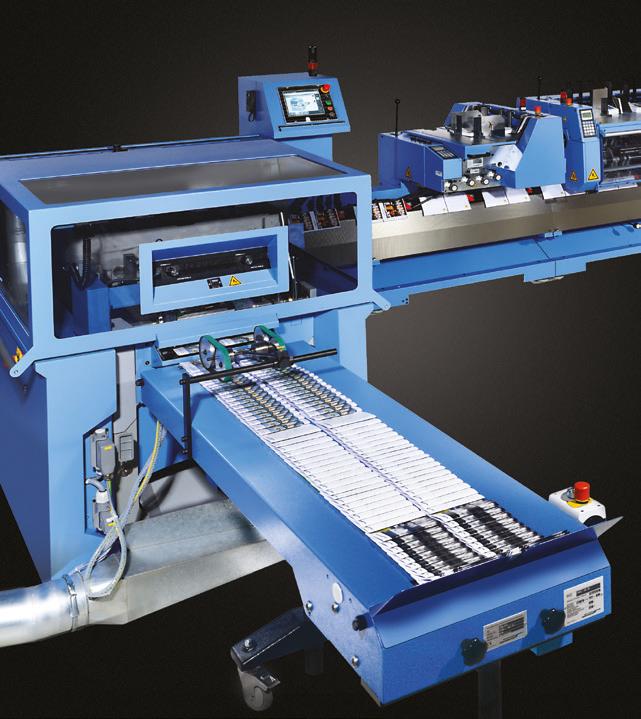
The current fashion system uses high volumes of nonrenewable resources to produce clothes that are used only for a short period of time before they are incinerated or placed in landfills.
This was a year of recovery for textiles and apparel as supply chain issues (still a problem) began to settle a bit, and suppliers were back online after the pandemic. Consumers were also buying – both online and back in-stores, which is good news for brands.

Sustainability is still a key issue for the industry, however incremental progress is being made. Some brands are all in, such as Patagonia.
The company has long been known as one of the earliest clothing companies to put sustainability at
the top of the list, from its inception, actually. In case you missed it, Patagonia founder Yvon Chouinard, a billionaire, is giving the entire company away to fight the Earth’s climate devastation.
Decision-making authority has been given to a
trust that will oversee the company’s mission and values. That trust controls 2% of the stock. The other 98% of the company’s stock will go to a nonprofit called the Holdfast Collective, which will use every dollar received to fight the environmental crisis, protect nature and biodiversity and support thriving communities.
Each year, the money Patagonia makes after reinvesting in the business will be distributed to the non-profit to help fight the environmental crisis. But they are an exception on the producer side.
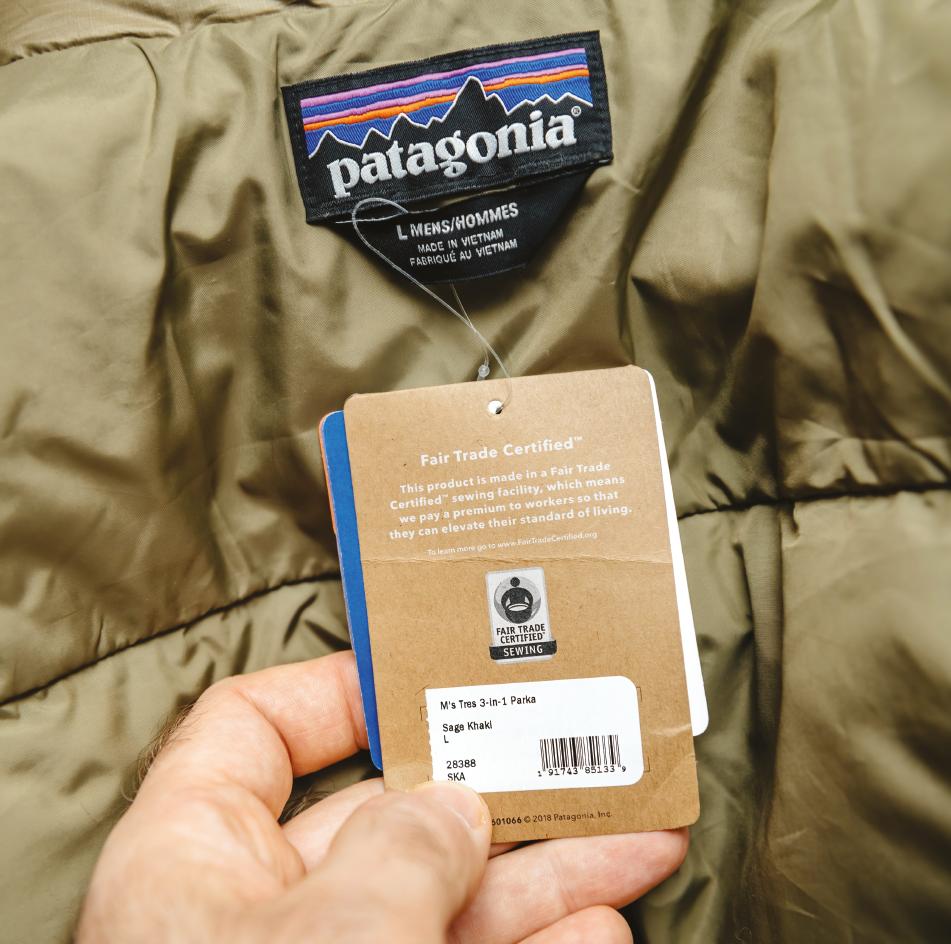
Too many companies are still focused on fast fashion and ephemeral trends. This has many dele terious effects on the environment – and is actually bad for the industry itself.
We see proof that going after revenue based on shortterm self-interest is to no one’s long-term benefit. Clothing is typically made overseas using labor that isn’t treated well. Brands negotiate tough pricing that gives them the best margins while making it tough for their suppliers to stay in business. Plus, a lot of that “stuff,” which none of us really needs, ends up in the landfill.

“Globally, an estimated 92 million tons of textile waste is created each year, and the equivalent to a rubbish truck full of clothes ends up in landfill sites every second,” according to recent data from BBC. “By 2030, we are expected as a whole to be discarding more than 134 million tons of textiles a year.”
The story states that the current fashion system
uses high volumes of non-renewable resources to produce clothes that are used only for a short period of time before they are incinerated or placed in land fills. And with 60% or more of the fabric content coming from fossil fuel feedstocks, these materials will stay in those landfills basically forever. So they use non-renewable resources that are wasted when the garment is worn once or twice and then thrown away.
We can certainly blame the brands for this behav ior, and we should. But consumers also need to play a strong role in driving change in this trend. If no one is buying the stuff, it doesn’t matter how cheaply it is made, the brands will ultimately be forced to change their business practices. It will take time, though.
That being said, many suppliers to the industry are working hard to develop more sustainable feedstocks. We expect to see this accelerate in 2023 and beyond, bringing the volume of these materials to a critical mass that can make a difference. Here are just a few examples.
One interesting project is underway at Lycra, perhaps better known by its generic names, spandex or elastane.
Back in the day, your jeans were probably 100% cotton. But as we saw waistlines expanding and con sumers looking for more comfort in the form of stretchy fabric, you would probably be hard pressed to find jeans that don’t contain some percentage of spandex. Comfortable, yes. Sustainable, not really.
QIRA, a new fiber from Lycra, will use feedstocks from field corn grown by Iowa farmers, and con sists of a next-generation 1,4-butanediol (BDO) as a primary ingredient.
BDO is a chemical commodity used to make polyesters, plastics and spandex fibers, but hereto fore has come from petrochemical feedstocks.
The result is an estimated 70% of Lycra fiber derived from annually renewable feedstock, saving up to 93% of greenhouse gas emissions when replacing fossil fuel feedstocks. The company also notes this substitution maintains the high-quality performance consumers are used to with Lycra.
can do even more with it than they can with natural leather without the immense ecological impact of the traditional leather-making process, from pastures and cattle feed to a wide range of toxic chemicals
Consumers also have a responsibility to look into manufacturer claims about their sustainability.
Biologic feedstocks are increasingly being used as well, including vegan leather created from almost any fibrous plant material, with mushrooms being at the top of the list.

Companies like MycoWorks and MyForestFoods are active in this space, and we expect many others to join the fray in the coming year. Some brands are already adopting these vegan leathers, but again, it’s a very small percent age of the whole market.
Smartfiber AG has developed a fiber created from seaweed, which is processed and mixed with cellulose to create a plant-based yarn. To ensure sustainability without over harvesting, produc ers harvest a crop every four years, giving the plants time to regrow. The plant is naturally dried, chopped and added to the cellulose.
It does use chemicals, but in a closed-loop process that does not release chemicals into the environment, as is the case with many other chemical-based processes. The fiber biodegrades and is compostable.
Brands and fabric manufacturers would be well-served to get in on the ground floor of these efforts. Maybe seaweed and mushrooms are not your thing, but there are plenty of other fiber types that do not use petrochemi cal feedstocks yet deliver the required performance.

In the case of mushroom leather, brands
For example, PrettyLittleThing, a fast fashion brand, has made big waves about launching a fast fashion resale marketplace. This is perhaps to compete with reputable resale sites such as Real Real, Poshmark, ThredUp and DePOP. But the big splash only represents about 1% of revenues.
Speaking of online and in-store resale and rental sites, we expect those to continue to gain steam in 2023. As I speak especially to Gen-Zers, a growing component of the buying population, they are taking advantage of these sites.
One friend’s daughter has been in multiple wed dings this past year and has used Real Real as the key source for bridesmaid dresses. These can be worn once and then popped back into the resale market for someone else to use, instead of ending up with a closet full of (often pretty ugly) brides maid dresses that will never be worn again. Wasn’t there a movie about that?
Another friend’s daughter has created her entire wardrobe using DePOP – buy, wear, sell back, buy something else, etc. The more these types of sites grow, the more pressure there will be on brands to change their business models.
Europe is way ahead of the U.S. in passing regu lations that punish greenwashers, but even in the U.S. pressure is being placed on manufacturers
across all industries that are putting forward false claims about their sustainability. As consumers, it is our responsibility to dig into the claims to validate their veracity and act accordingly.
We will increasingly see more digitalization of the entire supply chain in 2023 and beyond.
Digital textile printing continues to get faster, better and more affordable – especially when you look at the total life cycle cost. It enables companies like Raspberry Creek Fabrics and BMC.fashion to produce locally in smaller, highly customized runs with exquisite designs, eliminating all that back and forth of heavy fabric from Asia.
Cut-and-sew operations are popping up as well, including SAI-TEX in Los Angeles, BMC.fashion in Phoenix, Sonora Stitch Factory in Tucson, and North Carolina based Sparty Mill.
Again, these are just scratching the surface, but all are taking advantage of digital technologies, for design, production and for training, and helping reshore more of the textiles and apparel industry.
We should also mention the growing number of educational initiatives, such as ISAIC in Detroit, that are attracting new labor to the cut-and-sew business.
We can’t end this outlook without sharing news about Graphene and its increasing use in the textile industry. Why is this important? It goes back to getting rid of cheap, throwaway clothing and also making garments and other textile products more
functional.
Graphene, whether covalently bonded into the fiber or used as a coating, has many properties that add value to fabric and apparel. This includes increasing strength, improved abrasion resistance, thermal and anti-microbial properties and conductive properties, the latter of which will be making huge contributions to functional fabrics and wearables.
Graphene, discovered in 2004, has made its way into a number of industries, and is now gaining traction in textiles, including textiles used in the auto industry. There are already graphene-enhanced products on the market, including in sportswear, protective gear and more.
So keep a look out for new developments here as we move into 2023 and beyond.
Despite the reputation of the textiles and apparel industry as one of earth’s most prolific pol luters, progress is being made, and the new technologies being developed by suppliers to the industry –as well as pressure from consumers – are two keys to turning this bad situation around.
It’s a huge industry. It won’t happen overnight. But we expect to see new initiatives chipping away at the traditional models in 2023 and beyond.
We all have a role to play, whether we are suppliers, manufacturers, brands, associations, journalists, consumers or upstart companies looking to make dramatic changes. So the question for you, dear reader, is: What’s in your closet? ●
Graphene is increasingly used in the textiles industry.

For many years I have guided digital embellishment users on how to market what were originally very new concepts to their existing and potential custom ers. It was part of my role at MGI as we developed the JetVarnish range of inkjet-based digital varnish ing and foiling systems, and was broadened out when I established Taktiful last year to offer consul tancy on all aspects of all types of digital embellishment.
Mostly I think I was along the right lines a decade ago, but there’s one thing I now believe I got wrong, though for all the right reasons.
First, with digital embellishment very much a hot topic at this year’s LabelExpo and PRINTING United shows, this seemed a good time to ask some established users about how they market their services and
what levels of customer awareness they’re finding.
I talked to four U.S. service providers who offer digital embellishment, using either MGI or Scodix inkjet-raised UV varnish and foiling systems.
Darren Kenning, founder and owner of Sugar Print in Minneapolis, Minn., uses Scodix digital embellishment equipment.
Matt Greer, CEO at DMS Color in Birmingham, Ala., launched into digital embellishment four years ago with a pair of MGI JetVarnish machines.
Michael Dillon, chief revenue officer at Meyers in Minneapolis, Minn., has had an MGI JetVarnish for just over a year.


JohnHenry Ruggieri, president of SunDance Marketing Solutions in Orlando, Fla., bought a second-hand MGI JetVarnish digital embellishment unit five years ago.
DMS launched into small cartons around the time it installed its first digital embellishment units four years ago. It found a niche in packaging for the growing legal cannabis and CBD markets.
“When we’re talking to our customers about digital embellishment, we not only talk about the
Gold Leaf Packaging is flexing their digital embellishment samples for the cannabis industry.

benefits from a short-run per spective, but about sustainabil ity and how digital production is cleaner on the environment and our carbon footprint,” Greer said.

“We are really packaging that into an entire message that is delivered to the market that we’re targeting. So, if I’m going to use digital embellishments to produce greeting cards and birthday cards, then I need to develop a channel or a web-to-print platform, with a marketing message around that particular customer base.”

Dillon thinks the marketing message needs to be tailored to reflect what the client does.
“You have your mass marketing and then when you get a chance, you should do some better-targeted marketing.
“Sometimes we’re using it to show off what embellishment is capable of, from essentially the perspective of creating ‘bling.’
For a lot of groups, this is about catching somebody’s attention from a distance, down an aisle or across a store, and getting
them to come closer to pick up your package or to pick up your product.
“We’re talking differently when we’re marketing to emerging brands, who need to catch people’s attention and draw them in and get them to interact with that product and get to know that brand for the first time, compared with how we’re talking with established players who might have a particular product that they want to highlight.”
SunDance Marketing’s digital embellishment client sample packDillon recommends researching the potential end uses of digital embellishment out in the real world.
“I would say just spending time out in a store, getting familiar with who’s already using gloss, who’s already using foils and thinking about how this would be different?

“You need to separate who this is a fit for. If you’re talking about a very earthy health and cosmetics brand, this is not going to be the same kind of a fit as for ultra high-end cosmetics. And that’s where with time, some trial and error, and spending time out in-store, you learn how to better tailor that to these different audiences.”
Kenning says that putting results in customers’ hands pays off.

“Samples! We created a presentation folder with a bunch of different samples and effects, with over view instructions on how to create a digital file. That’s what we hand out to our potential customers, because really it’s that touch and feel and seeing it.
“I think we do a pretty good job on our website to show close ups of the effects. Getting a close up in the right lighting to really show off that enhancement is great.”
Ruggieri admits that it took time to get the marketing right with SunDance’s original
foray into sleeking.
“We tried to brand it on our own. That was relatively unsuccessful other than for our major clients that were using it.”
He also feels his sales team initially needed help in understanding how to sell it.
“In my opinion, they were just using it as a cheaper way to get foil stamping. But now I have a few sales people who are basically my rock stars, my solutions sellers. They get it. They use it in the right applications.

So, the whole digital embellishment sector could benefit from lifting market awareness. Whose job should that be?
Dillon says it should be a bit of everybody’s responsibility.
“When we saw these machines and thought what they were capable of, we knew that we wanted to be able to bring that to brands and help them understand how they could do things they weren’t yet doing. So in that case, it’s really on us. But it also took the people who create these machines, MGI and others, to be in a position to
explain to us that ‘this is out here, and this is why it’s different from what you’re doing today.’ So everybody has their own part to play in that.
“Some brands are just not in the position to have people out exploring. So if you want to bring something creative and new to brands, whether you’re a consultancy, manufacturer or design agency, it’s on you.”
Finally, here’s my market ing mea culpa. I went around for 12 years telling everybody, “Hey, listen, here’s what you do. Come up with a really cool name for your digital embellishment offering, put your name in there, copyright it, and market the hell out of it. Create your own digital embellish ment brand and establish that your secret sauce is unique to you.”
That made sense at the time.
I’m realizing that pushing that line may have caused significant confusion at the brand or agency level, because now they have hundreds of different names for essentially the same thing.
If everyone uses different brand names and terminology for what are broadly the same set of effects, new customers might find it difficult to understand what they’re being offered by different service providers.

By contrast, everyone is likely to know and use the same terms for traditional embellishments, such as hot foil embossing.
Ruggieri came up with the brand name SunShimmer when he adopted foil-over-laminate, which is generally called sleeking.
“I think it was a major mistake and that we confused the market,” he said.
Establishing standard terminology is one of the goals of the new Digital Embellishment Alliance, an offshoot of the Foil & Specialty Effects Association. This promises standardization initiatives, designer outreach, trend analysis and brand education. You can learn more at www.fsea.com ●
With the explosion of technology, internet presence and big data, MarTech has become increasingly important for companies of all sizes and types over the past decade.

Similar to new “hip” terms like FinTech, InsureTech and SecTech – MarTech stands for marketing technology, while MarTech Stack refers to the full software stack being used to handle, measure and enhance your marketing and communication endeavors.
Whether you’re a PSP, MSP, commercial, trade, packaging or wide format printer (to name a few), your customers turn to you for immersive, tangible experiences that boost brand recall and convert more buyers.
However, while you may be helping your clients, it’s easy to forget (or often ignore) your own needs. MarTech software enables you to market your own business as well as your clients’, gaining customer and business insights about who’s buying what, who isn’t, and what your quickest time to money is when it comes to drumming up more business.
With great data management software and campaign management tools, you can assist your clients with their lead generation efforts – involving yourself with their success in a more intricate and
valuable manner than the competition.
If you provide direct mail, for example, having integrated opti-channel capabilities becomes a high-value, added service – that better distin guishes you from your competition. Even out sourcing some services can mean a big jump in perceived value, translating to higher job prices and profit margins.
The Martech Landscape grew 24% from 2020. The drive to deliver better customer experi ences and streamline operations accelerated the demand and inspired a new wave of start-ups in the space.
Chiefmartec.com categorizes marketing technology into six buckets: 1. Advertising and promotion 2. Content and experience 3. Social and relationships 4. Commerce and sales 5. Data and analytics 6. Management
Each can be broken out into numerous subcategories, with thousands of options to choose from depending on the goals and/or needs at play. To put in perspective how deep the pool is, today there are roughly 10,000 MarTech solutions on the market, and the growth is not slowing down. In 2017, there was half that amount; in 2012 there were less than 500.
How to navigate the ever-expanding MarTech landscape.

The Cloud Advances in internet capabilities have resulted in many cloud-based solutions coming to the fray, offering connectivity, integration, easy collaboration and ultimately increased marketing productivity and ROI. With so many people shopping, browsing and using social media, technology helps capitalize on these new buyer hangouts. From advertising to ana lytics, there are a myriad of online and mobile solu tions to help you attract and engage your ideal buyer.
In the age of social media and instant streaming, getting and maintaining prospect attention is more difficult than ever. Hyper-personalized strategies are becoming a must, inclusive of interactive and engag ing content that reaches audiences across their favorite channels and platforms. Fusing print to the digital mix through QR codes, custom maps, embel lishments, imagery and hyper-personalization boosts response rate by 63%. Software solutions that are designed to assist, innovate and streamline your workflow help cut through the clutter and noise.
To truly target who you help, how you help and why it matters, your company requires organized, accurate data. With the right dataset, you can pinpoint your quickest time to money and attract those customers
most likely to buy in the shortest amount of time.
CRMs, SEO, integrations, analytics tools and even project management and collaboration solutions all ultimately help you do more with less by efficiently managing data. With thousands of solu tions offering different businesses the ability to collect information around purchases, customer behaviors, demographics and so much more, there is no longer any excuse for bad data – only bad habits.
As with any other aspect of business, planning and building the technology stack that’s right for your business involves strategy, research and trial and error. A large majority of solutions have a trial period that lets you play with all the bells and whistles before whittling down your must-haves from your nice-to-haves.
● Website Analytics (aka: Google Analytics) –Set up right, this will tell you everything you need to know about the comings and goings on your website.
● Content Management System (CMS) like WordPress – So you can create, manage, modify and publish website content with little to no coding knowledge required.
● Customer Relationship Management (CRM) system
– You all should know this one! It’s where all your contact data is sorted, analyzed and prioritized throughout the prospect to customer journey.
● Marketing Automation Platform (MAP) such as MailChimp – Integrated with your CRM and CMS, your MAP automatically collects contact information that you can segment for email blasts, newsletters, digital campaigns, etc.
● How will success be measured?
The clearer the answers, the easier it will be to identify what solutions you should be looking at and how they are going to improve your business.
Use those free trials. Reach out to your network and ask what’s working for them. Get comfortable with the process and benefits of utilizing MarTech. Get familiar with how these solutions function. Analyze what aspects of your business they are assist ing, and how much they are doing so. Ask yourself whether the impact is of justifiable value, and always consider what features you need vs the ones you want. And last but certainly not least, think about how you can put these tools to work for your clients.
Building a MarTech Stack doesn’t only boil down to the selection of a few pieces of software. It’s an ongoing process that requires you to be constantly examining how much improvement you’re seeing while ensuring your software is up-to-date, and meeting your needs as you grow.
Always keep the bigger picture in mind as you navigate through learning about what each of these technologies can do for your business. And remember, you get what you pay for.


Once you know what stuff does, the next step is asking the right questions to help you choose a solution that will help you now, next and later.
● What solutions will help my business realize its short-term goals?
● Is our current setup working optimally?
● What’s the budget?
● How will our MarTech Stack provide us with ROI?
● What resources are required to implement, run, maintain, etc.?
● How long will this setup support our current needs and long-term goals?
This entails staying on top of your CRM, ensuring your databases are cleaned, your W2P is optimized for search and your campaigns are thought out and personalized.
Before you go out and blow tons of dough on the biggest and baddest CRM or MAP, make sure you know what they do, and what you need from them. The sheer number of solutions to choose from, coupled with deciding precisely what software you need for your business model, can be overwhelming. But despite the challenge it may provide, it’s impor tant to get bearings on how your print business can benefit from new or upgraded MarTech to impact efficiency, productivity, and ultimately growth. ●
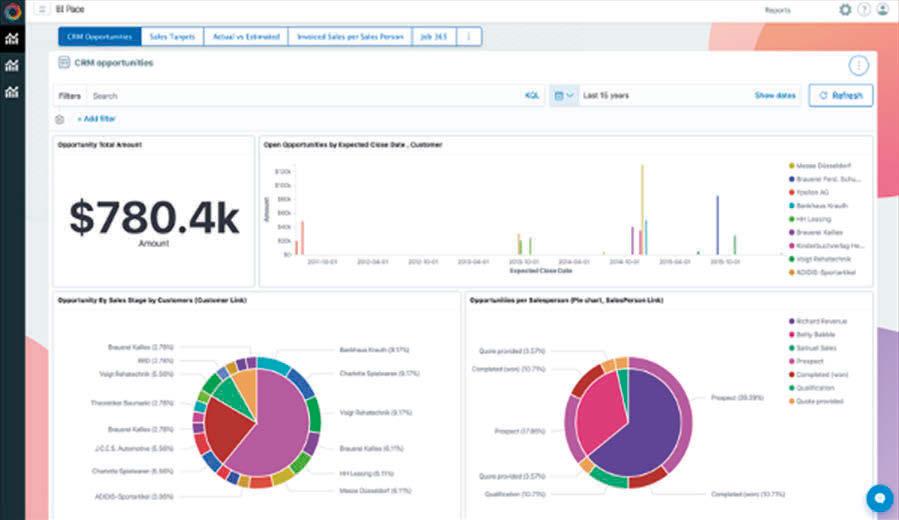




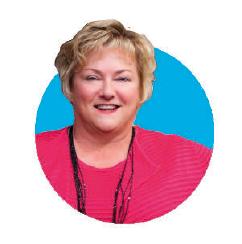


is a leading global provider of packaging and print software solutions. We offer integrated, automated, and purpose-built software technology for MIS and ERP, eCommerce, and industry-specific point solutions designed to:
• Drive revenue growth
• Reduce manufacturing costs
• Empower business agility and transformation

If you haven’t reviewed and revised your “Sales Playbook” in the past couple of years, it may be holding you back. The world of professional sales has changed dramatically, and your book may be out of sync with current market reali ties. Let’s look at a few critical changes affecting each sales stage.
Key changes over the past few years include:
● Prospects are inundated – extraordinarily little mindshare available
● Dramatic increases in turnover means new decision makers and influencers.
● Teams/Slack – diverting attention away from email. Phone access is also dramatically reduced.
Noticeable shifts over recent years include:
● Virtual world makes it challenging to build connections and trust, making it difficult to ask important qualifying questions
● Prospects have a multitude of choices, making it hard for them to determine the people with whom they should engage.
● Prospect receptivity “window” is smaller than ever. Much of the buying process is completed
Lisa Magnuson is the author of two highly acclaimed books: “The TOP Seller Advantage: Powerful Strategies to Build Long-Term Executive Relationships,” and most recently, “The TOP Sales Leader Playbook: How to Win 5X Deals Repeatedly.”

without engaging sales; in some cases skipping the qualify stage entirely.
Important trends affecting buyers and sellers include:
● Executive sponsors protect their time like never before, making it very tricky to develop solid executive relationships.
● Buying teams are growing at an exponential rate, with stakeholders from unlikely parts of the company – including global representation.
● Emerging prospect concerns with security or risk of any type mean that new influenc ers may come from security, compliance, risk, legal, HR, IT or other areas.
Recent market changes include:
● Trending are younger decision makers, possibly millennials or Gen Z.
● Presentation attendees have short attention spans and little tolerance for generic content.
● Prospects indicate they expect proposals to go well beyond the benefits for their organization. They want to see the impact and results they can expect.
Key changes over recent years include:
● Turnover affects large opportunity teams, especially 5X opportunities (those worth
about five times your average deal size) which can span many months, or even years, leading up to a win.
● Less time in the office means win celebrations may be virtual.
● Infrequent business travel impacts key touch points such as new project kick-offs - affect ing important new client connections.
Statistics point to:
● Statistics indicate that clients want longer term partnerships with fewer suppliers.
● Clients expect value and results for all services rendered, and expect providers to track and report the impact of services on a regular basis.
● Account teams may be spread out geographi cally making strong coordination of expansion strategies more critical than ever.
The above realities are general, but if you take the time to review the impact of the last few years on your industry and your prospects’ companies, you will surely see the deep impacts to your “Sales Playbook.” Just one missed element can mean a stall or
stop. Invest in revising your book so it won’t hold you back.
Seize the opportunity to review and revise your “Sales Playbook,” and it will lead to increased wins. Don’t forget to “ring the bell,” even if you must do it virtually. ●

Joe Gass, President and CEO of Heritage Printing, recently launched Heritage Signs & Displays and BlueFire Visual to transform interior spaces. Find video here: https://bit.ly/3DiQ6Cq

Koenig
Koenig
Find video here: https://bit.ly/3SOO02C
TLMI’s
Linnea Keen, President of Tag and Label Manufacturers Institute (TLMI), talks about growth and add new members. Find video here: https://bit.ly/3TOWTdR

Web-to-Print Solutions that Adapt to Your Needs with Customer’s Canvas CEO and Founder Dmitry Sevostyanov tells us why Customer’s Canvas is the solution for every customer. Find video here: https://bit.ly/3Fuc2gE

RMGT “Commit to Print World Tour” at PRINTING United



RMGT stopped at PRINTING United for a sold out showing of the RMGT 9 Series Offset Pres Find video here: https://bit.ly/3DKVO1h

Frank Mallozzi Looks Back on 25 Years at EFI Frank, Chief Revenue Officer of EFI, talks about his experiences over the past 25 years and the opportunities ahead. Find video here: https://bit.ly/3DmLsD8

Folding
David
Find video here: https://bit.ly/3WbBZHv
Raspberry Creek Fabrics Continues to Grow, Innovate Co-founder Justin Rammell tells the Raspberry Creek story, explains the recent patent the company acquired, and mentions a move into wallpaper. Find video here: https://bit.ly/3zrJEaT
DMS
Taktiful’s Kevin Abergel talks with Matthew Greer, CEO of DMS Color/Gold Leaf Packaging. Find video here: https://bit.ly/3fhEJm8




Taktiful’s Kevin Abergel talks with Michael Dillon, the new Chief Revenue Office at Meyers. Find video here: https://bit.ly/3DbeJkk
DALIM Software at PRINTING United DALIM Software’s Aristide Zouheir-Kuhnle talks about DALIM’s software solutions on display at PRINTING United Expo. Find video here: https://bit.ly/3U8ZfEa
Hybrid Software Group at PRINTING United Hybrid Software Group CEO Mike Rottenborn talks about the evolution and growth of the company. Find video here: https://bit.ly/3gVaiTn

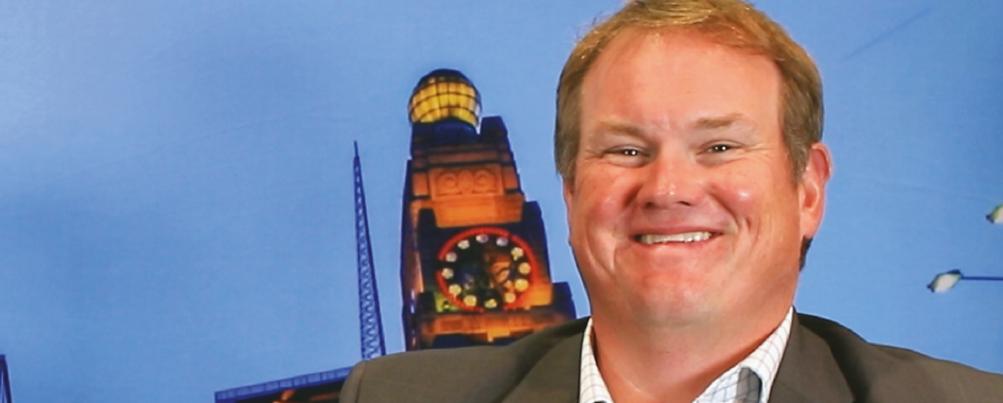
Vanguard’s Award-Winning Wide-Format Printers in Display at PRINTING United Vanguard Digital Printing Systems’ Jim Peterson talks about the equipment the company was demonstrating. Find video here: https://bit.ly/3zqtcYz
PRINTING United 2022 Opens in Las Vegas!


PRINTING United Alliance CEO Ford Bowers talks about the first in-person PRINTING United Expo since 2019 and the themes and trends on display at the show. Find video here: https://bit.ly/3foqpIq
Tom
About Being Acquired by Taylor Corporation His enthusiasm for his new role is evident and we will continue to follow his news as it develops. Find video here: https://bit.ly/3fi98km
Warren Werbitt Goes Printer to Printer with Awesome Graphics’ Tami Napolitano
Founded in Napolitano’s attic, the company now has a 5,000-sq. ft. commercial location, 11 employees. Find video here: https://bit.ly/3gVzatV
O’Brien of AccuLink/AccuFlex Talks Color’s Matthew Greer on Marketing Digital EmbellishmentInteractive print is mainstream.
By Heidi Tolliver-WalkerIf there is a story in interactive print these days, it’s accessibility. Both for service providers and for their customers.
The range of applications is staggering, from 3D product visualizations and virtual try-ons to AR filters, virtual brand ambassadors and 360 tours.
While these applications used to be out of reach for small to mid-sized commercial printers and their clients, that is no longer the case. Whatever experience you want to offer, someone has a platform to make it easier and more accessible than ever.
The mainstreaming of interactive print is driven,
in large part, by WebAR, in which the experience is activated by QR code, hyperlink or text message. No app is required.
“Now that people no longer need an app to download, we are doing as much as possible with a simple QR code scan,” said Will Gee, CEO of Balti Virtual, an XR agency in Baltimore, Md. “The main goal is to use AR to tell a deeper product story and give potential customers a better ‘feel’ for a product than they would get through traditional print.”
As an example, Gee points to Under Armor’s AR-fueled catalog “The Better Book” that dropped in late October 2022. The cover has a QR code that leads to an AR experience showing a woman in Under Armor gear engaged in an intense workout.

Additional QR codes throughout the interior or the book turn photos into videos designed to motivate shoppers on their own fitness journeys.
On the B2B side, Balti Virtual created an AR experience for Stanley Black-and-Decker that the company used as a handout at a trade show. Stanley Black-and-Decker was looking to promote the innovative features of its new DeWalt PowerStack to trade buyers.
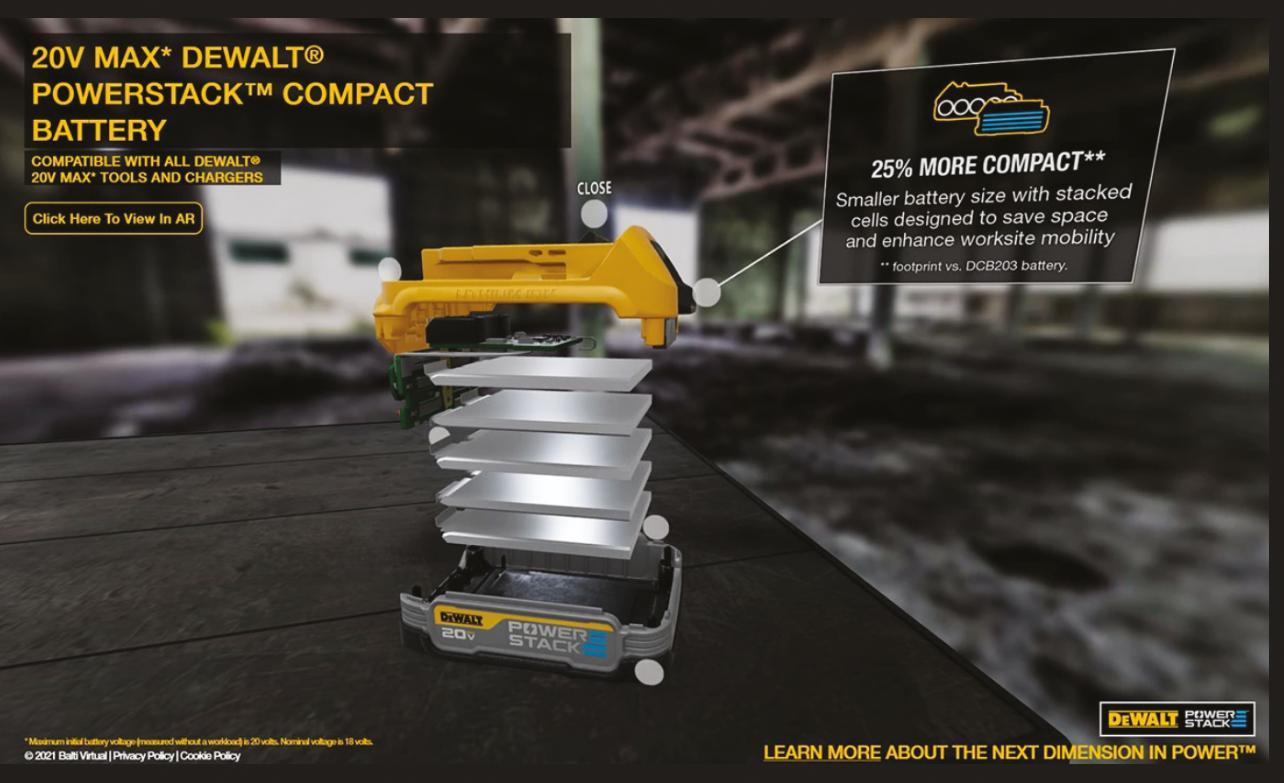
Launched by scanning a QR code, the experience first shows the battery in its resting state. Once the visitor clicks to expand the product, the battery animates into an exploded view that highlights key features of the product. Each feature is linked to an interactive hotspot that expands with the infor mational text once a user taps the hotspot on their phone’s screen.
Notable in many of these deployments, is that AR is moving beyond mere entertainment to a tightly controlled brand experience with a clear call to action.
“The idea of the image scan of a poster or brochure that brings it to life with animation is cute and nice, but it doesn’t have a lot of utility for the user other than entertainment value,” said MJ Anderson, chief expe rience officer for RealityBLU. “These days, we’re more focused on moving people to a call to action.”
Anderson gives the example of a political mailer created by DME Delivers (Daytona Beach, Fla.) on RealityBLU’s WorldViewAR platform that dropped earlier this fall.
The mailer used a holotwin (holographic twin) of the state-level candidate soliciting donations to his campaign. To access the experience, recipients scan the QR code, anchor the holotwin on any flat surface by using “tap to place,” and the can didate’s holotwin pops up in the
viewer’s environment and begins to speak.
“When done properly, we are seeing virtual activation rates of 10% to 20% on these mail pieces,” Anderson said. “This political mailer has generated a 13% activation rate, and it hasn’t been in the field that long. That’s 13% of recipients having scanned the code to see the AR scene.”
Packaging is another important channel embracing AR. This market has been slower to embrace the more practical side of AR, however, still focusing largely on AR-fueled games and brand experiences.
Zappar Creative Studio team, for example, recently built an experience to be layered onto Nestlé cereal packaging showcasing a collaboration
As part of Nike’s PLAY NEW initiative, the brand launched in-store “adventures” via AR-fueled stickers placed throughout select stores.
 Stanley Black-and-Decker was looking to promote the innovative features of its new DeWalt PowerStack to trade buyers.
Stanley Black-and-Decker was looking to promote the innovative features of its new DeWalt PowerStack to trade buyers.
with Marvel superheroes. By scanning a QR code, customers can “unlock” Marvel Avengers face filters and take a snap with them.
Speaking on a Zappar podcast, Richard Hess, immersive experience lead for Nestle, described AR as an important focus for the brand giant right now.
“How can we use AR as a vehicle for storytelling and providing more information about the product in a way that is more engaging than traditional 2D [channels] such as packaging or digital banner ads?”

Hess notes that Nestle is not looking to simple one-off campaigns, but to scale AR into some thing larger.
Other AR packaging experiences from Zappar include on-packaging AR game experiences designed for McDonald’s and King’s Hawaiian.
Other growing applications for interactive print include business cards, books, posters, city billboards, subway posters, bus stop advertising and in-store displays.
For books, AR brings the imagination to life in a way that even the most beautiful images and illustrations cannot.
This was recently illustrated by Sylvanmo paper, which released a new chil dren’s book, “Apollo and the Treehouse,” the continuing adventure of Apollo the dog and his seven-year-old owner, Andi. Designed

to both promote Sylvamo’s Accent Opaque Super Smooth and the importance of sustainability, the artwork springs to life on the page through AR.
Large brands continue to till the ground for AR, and by doing so, mainstream the technology and set consumer expectations.
Walmart is working on a new AR technology that will allow shoppers to point their phone camera at store shelves and, via the Walmart app, identify and filter items based on their product preferences. It is also rolling out a feature that lets customers view AR-enabled furniture and homedecor items virtually in their homes.
In-store gaming experiences are a growing opportunity, as well. As part of Nike’s PLAY NEW initiative, for example, the brand (working with BRDG Studios and 8th Wall) launched in-store “adventures” via AR-fueled stickers placed throughout select stores.
Poplar Studios worked with artist Cyril Lancelin to create buzz around the opening of the new Coach store in London’s Soho Square. Launched via QR code, users can explore the artistic installation to “collect” virtual hearts for a chance to win one of its Pillow Tabby handbags.
Interactive print is now everywhere — if you know where to look. Whether it’s a direct mail piece, a poster, business card, shelf sticker or interactive display, the pandemic-driven rise in QR Code usage has opened doors to opportunities never before thought possible. With the advances in technology and dropping costs, AR is increasingly accessible to service providers both large and small.
●
“Apollo and the Treehouse” is designed to both promote Sylvamo’s Accent Opaque Super Smooth and the importance of sustainability.
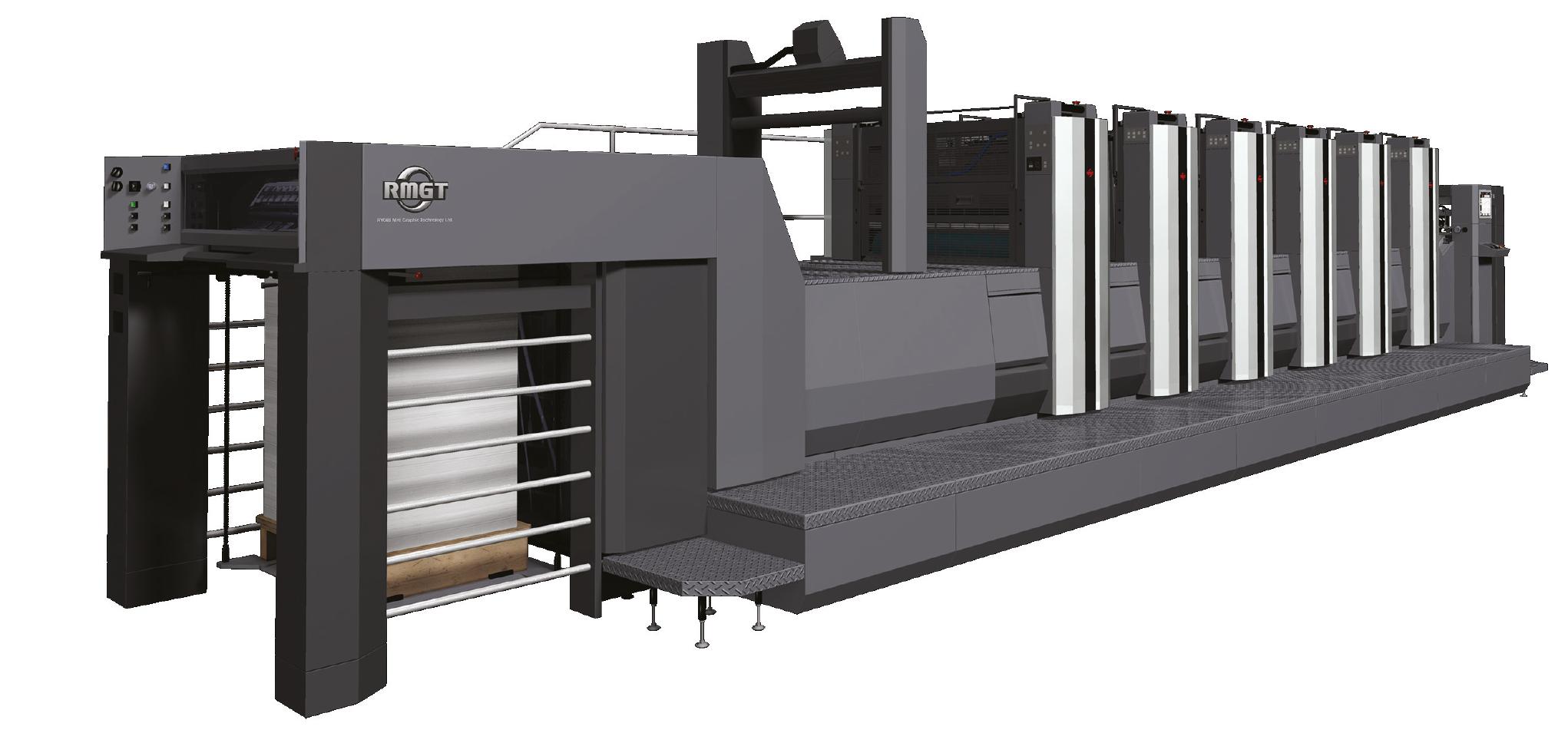
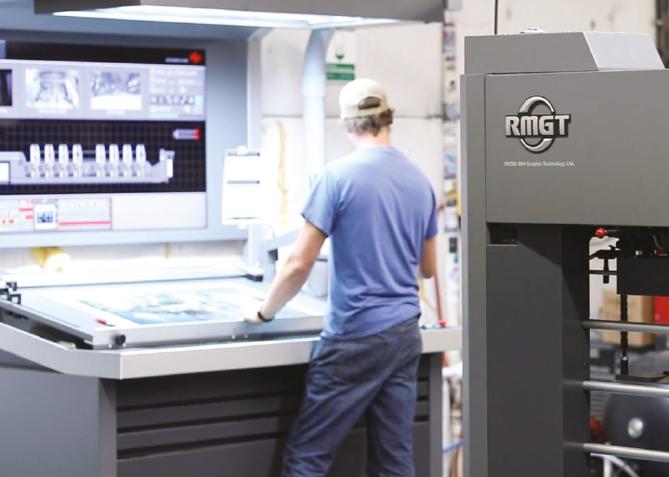
Offset lithography was the predominant printing process of the 20th century, and it has given up only limited ground to alternative printing methods in the 21st. Manufacturers of offset press equipment say they still see it as an essential product to deliver and a vibrant business to be in.

This would be expected of any OEM with market share to defend and customer loyalty to preserve. But these OEMs are also deeply realistic about changes in demand that have obliged them to adapt their product offerings and their marketing strategies in new ways.
They’re confronting trends in print consumption, technology requirements and human factors that didn’t previously exist.
The equipment may have changed, but the OEMS haven’t altered their habit of keeping a close eye on how their customers’ customers are behaving.
“We moved from ordering on demand to almost just in case,” said Clarence Penge, executive vice president of product management, Heidelberg USA. “People think there’s going to be a shortage, and they order higher quantities as materials become less available or scarce.”
This can lead to “panic” in the minds of some print buyers, who then pass it on to their PSPs as orders for extra printed matter to hoard.
“With everybody concerned with inventory, the supply chain and current world events, people are actually stocking up a little bit more,” said Eric Frank, senior vice president, marketing and product management, Koenig & Bauer (US/CA).
Order quantities may have shifted, but other long-standing customer expectations are still firmly in place. “Perfect, fast and free” is what print buyers ideally would like from their PSPs, said Lance Martin, vice president marketing, Komori America & MBO America, Komori America Corp.



There’s also a rising awareness on customers’ part about the environmental impact of printing.
“It can’t be wasteful,” Martin said. “Customers do worry if a plant is not being green. That’s an issue.”
However, print buyers have become easier to satisfy when it comes to substrate selection, given the series of shortages they’ve had to put up with.
“They’ve been more flexible about whether they can get, let’s say, a 70-pound satin versus a 60-pound, more or less taking what was available to
help meet their price,” Penge said.
But a concession to tightness in the paper market doesn’t signal any reduction in their insistence on excellence in the finished product.
“Our customers’ customers are focusing on quality and consistency, because they realize the power of brands in today’s marketplace,” Frank said. “They’re looking for embellishments, enhancements, tactile experiences and more colors.”
All of these external influences play into printers’ decisions about capital investment in offset equip ment. But they have their own considerations as well, and chief among these is knowing how to select presses that their personnel actually can operate –today, and in the labor-constrained years to come.

“They are definitely looking for any way to elimi nate labor,” said Kevin Neureuter, director of sales, USA and Canada, Manroland Inc. “Labor seems to be the most significant issue that they’re having.
half or two years had he not stuck with that investment, because of being able to do more work with far less labor,” Manley said.
With its large installed base of aging press machinery, the sheetfed offset market is ripe for this kind of updating.
Manley sees the quest for productivity in high volumes as another key driver.
“In a lot of the two- and three-presses-for-one transactions that we’ve done over the last six to seven years, the rolling gear in some of these shops was so old,” he said.
However, printers still haven’t found any other process that gives them a better way than offset litho to “pound out 25 million impressions a year worth of 24” x 36” eight-up sheets,” he added.
The need to make print production a “less artful” process is the single biggest motivating factor in the decision to acquire a new press, Martin said.
“It has to be controllable. It has to be a direct process with small amounts of waste,” Martin said. “[In the old days] you had hundreds or thousands of sheets of make-ready and lots of labor to fix prob lems. None of that can happen anymore. It’s about turning an artful process into a more manufacturing-controllable process.”
Where we used to have three people on a press 20 years ago, two people on a press today is already too many.”
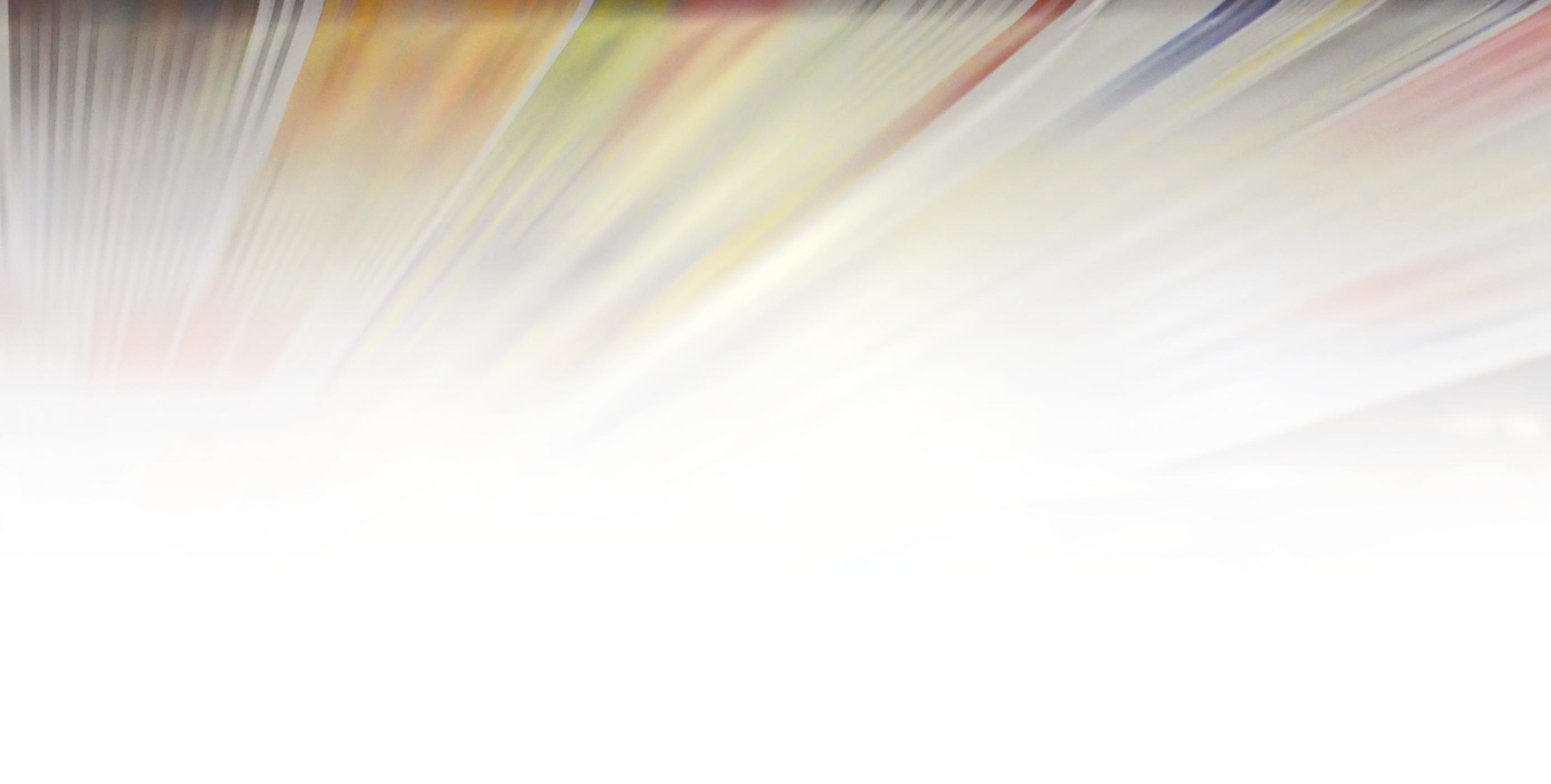
Chris Manley, president of Graphco, said that soon after a Graphco customer replaced three presses with a coater-equipped 10-color RMGT Series 9 perfector in the summer of 2020, the printer saw its volume grow by more than 25% – with one operator producing all of it on a single 10- to 12-hour “long shift” supplemented by a partial second shift.


“He probably would not have done anywhere nearly as well over the last year and a
Printers expect OEMs to build presses that deliver the kinds of products their customers want with the production efficiencies their businesses depend on. This is reflected in the features that printers now consider must-have in the configuration and capabilities of offset press equipment.
“What’s enticing people to buy is efficiency, but it’s also that they realize they don’t want to run
something twice through the press,” Frank said. “They want single-pass production.”
The right design for achieving this includes complex arrangements of printing and coating units, operator-supportive press logistics and endto-end automation.
The sweet spot, according to Manley, is being able to provide a 4/4 or 5/5 one-pass solution at a price point that matches or comes in below the cost of the “classic” six-color plus coater.
UV curing, particularly when done with LED UV systems, is in steady demand because it expedites finishing with fully dry press sheets that can go straight to post-processing.

A nagging supply chain issue underscores the desirability of coating in an especially timely way.
“A significant group of people are looking at double coaters on the presses, mostly due to the struggles they’ve had with getting high-quality paper,” Neureuter said. “The first unit can also be used for sizing the sheet so that they have a good printing surface.”
Coating also is popular for special enhancements like visual gloss and raised, tactile surfaces. RMGT calls the latter effect chemical embossing, and according to Manley, its appeal to high-end producers is irresistible.

“Once a customer has that three-dimensional aspect to their print, along with the gloss highlighting whatever the callout feature is of that printed piece, they never want to do without that,” he said.
A printing company that depends on short makereadies and rapid job changeovers to operate profitably, is a natural customer for pressroom logistics: mechanized solutions for streamlining the flow of production materials to, around and away from the press.
The OEMs understand, however, that a printer’s embrace of automated production will be a gradual process, not an overnight transformation.
“[Workflow] is all behind the scenes,” Penge said. “It’s very hard to see what’s going on and what could potentially be improved. There’s a little bit
of a reluctance to change workflow because of the unknowns they can’t physically see.”
But the hardest part of implementing automation may be getting operators to make full use of it.
That means convincing them to “trust the software to do what it does,” Martin said. “You have this wonderful automated press, and the guy picks up the sheet and starts adjusting color the old way on the console, not trusting the press to do it.”
The OEMs’ realism about present conditions in the market for offset litho equipment carries over to their outlook for what lies ahead. The consensus among them is that if a general economic downturn happens, the market will react accordingly – and then rebound.
Neureuter said that some customers, especially those in the commercial print segment, have started to defer purchasing decisions into next year.
Frank said that because of continuing supply chain snarls, press delivery times are taking up to 25% longer than they used to.
“So people have to prepare a little bit in advance,” he added.
Manley believes that if a recession occurs, printing will be a “lagging industry” that enters it later and emerges from it sooner than other parts of the economy.
Penge thinks that in any event, pressures on printers to cut costs and deal with labor shortages aren’t going away.
Martin said a shop running old, individually crewed, straight-printing presses has no real way to compete against a shop with an 18,000-sph perfector that can produce the same volume of work “with two guys running the press, or a guy and a half.”
But even as that segment of the industry continues to decline, the offset market as a whole looks robust.
“I think the offset market is underestimated,” Frank said. “It’s still strong and viable, and it’s a proven process that works. When people say offset is dead, they are dead wrong.” ●


Insignia is a truly unique feature packed system eliminating the need for multiple machines, staff and stock movement.
Loaded with high-value features Die-cutting, kiss-cutting, embossing, creasing, cut-scoring, perforating, in-line fold/glue, plus automatic matrix removal—all in one pass! With speeds up to 5,000sph, it handles stocks up to 30pt board.
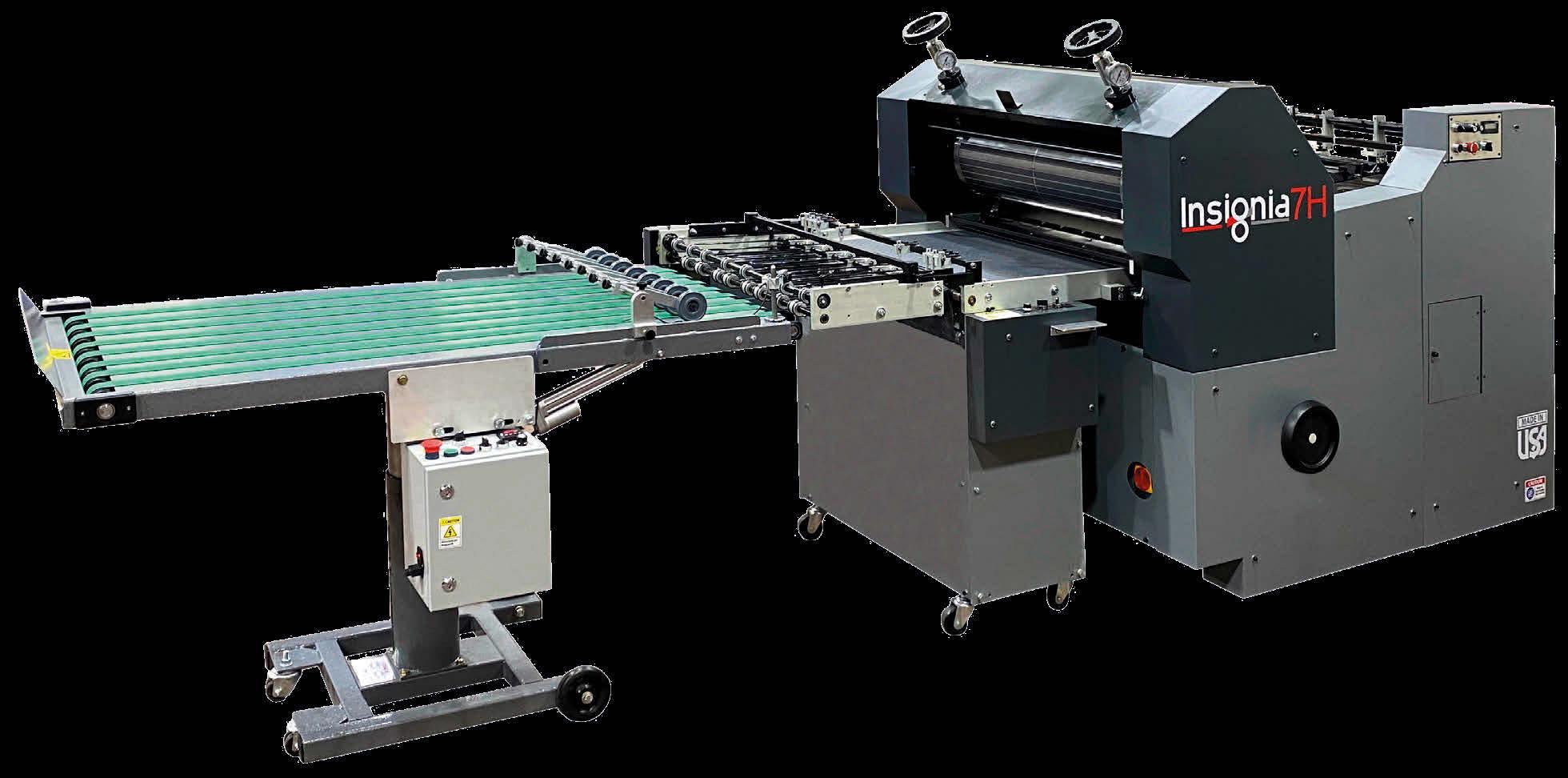
Out with old methods—in with the new. Non-skilled operators easily adapt to using Insignia’s flexible dies. Ideal for creative finishing from digital presses, up to B2 sizes. The Insignia production-built machines are manufactured in the USA and come with expert support and training by Rollem’s specialists.

Alack of global industry events entailed a slowdown in launch activities this year. However, some remarkable inkjet products were still brought to the market.
Kodak improved productivity for two-up inkjet presses with the Prosper 7000 Turbo Press, upping the web speed to an impressive 410 m/min (1345 fpm).
Most recently, HP launched the Advantage 2200 as a new platform for the two-up market and a basis for additional future models.
Miyakoshi is about to launch the MJPEXG20, a very compact, low-priced web-fed color inkjet press for decentral printing.
Sometimes devices are announced multiple times. On a few occasions, a device is so extraordinary that we are still excited to hear about it, especially when a first install takes place.
After being previewed several times, the AlphaJet from MGI was officially launched this fall, and a first installation is already in opera tion at a French security card printer. The B1-format AlphaJet can combine several printing and embellishment
features in one press and can be configured for a wide range of (specialty) applications.
Again, there was considerable activity in corrugated/display presses. EFI launched two new models (Nozomi 14000 LED and Nozomi 18000+), while HP introduced the T700i.
The launches of label presses are too numerous to list, especially hybrid presses, combining analog and inkjet units.
With so much focus on inkjet, launches in EP technology are sometimes overlooked. Some key launches this year show the technology’s potential, like the HP Indigo V12 pushing the web speed to 120 m/min (400 fpm).

Less spectacular, but with implications for a large customer base is Canon’s revamp of the imagePRESS line with the V-series.
Konica Minolta even launched a new monochrome toner device, pushing the top speed of the AccurioPress line to 272 ppm.
Once the full year installation numbers are in, it is likely that 2022 was a decent year for press sales, although not as good as hoped. Paper shortages, energy price increases and an uncertain economic situation did weigh down on a printing industry in recovery.
Book press sales saw another good year in 2023, as well as the resurgence in direct mail, after a slump during the height of the pandemic, led to more installations.
Inkjet is moving into commercial and online print, although at a relatively slow pace. There is little doubt that top-end inkjet presses can deliver the quality required, however, established processes and preconceptions are still slowing the uptake. There were some remarkable wins in security and gaming printing with inkjet presses.
Packaging is tipped to be the next big growth market for digital print. It is certainly the case for label printing where a constant stream of presses is entering the market and the uptake is high.
While EFI made good gains in corrugated/display installations and HP had several installations as well, there were few sales from
other vendors. Even fewer installations were publicized in flexible packaging or folding carton print, with vendors still taking time to tweak the devices to the customers’ requirements.
Investments were not only hampered by the political and economic situation, but also by supply chain issues. Vendors of inkjet presses were restricted by a lack of components, and several claimed that they could have shipped more. Sales of some toner printers were affected as well.
This fall vendors stated that the situation is alleviating, but it is still far from normal.
Forecasting has never been easy, and this year is even more difficult.
There is a consensus among industry pundits that 2023 will be another year of insecurity and volatility.
“All companies had to rethink their go-to-market strategies and find a balance in an uncertain world,” said Corporate Communications Manager Danny Mertens at Xeikon. “The current global challenges everybody is facing are transforming the world. Some of that transformation is to our advantage. Often it means that as a company you have to see this as an opportunity and transform as well.”
Digital inkjet is taking advantage of new technology and supply shortages.

“The print market is currently facing enormous challenges and will most likely continue to do so in the coming year,” said Randy Vandagriff, senior vice president print, Kodak. “Risks are on the rise as global supply chain issues continue to impact the supply of raw materials. Labor challenges continue to affect manufacturing and distribution, and prices continue to increase.”
Nevertheless, Jennifer Kolloczek, senior director, marketing, digital production printing & solutions at Canon EMEA still sees a positive atmosphere in the industry.
Although the fear of recession is in some cases causing printers not to spend, many do invest in flexible and versatile production tools. The interest in inkjet is not going to stop.
She added that Canon invested heavily in the supply chain to secure availability. The most important thing is to keep customers running.
The printing industry is tipped to see a bigger push toward automation in 2023. Not only does cost pressure remain a driver for automation, but the lack of staff is often an even bigger driver to automate. Automation does not stop at the press, however – it includes the workflow as well.
“To meet the heightened need for optimised cost efficiency, automated production and marketing workflow solutions will be needed to handle jobs with minimal human intervention and to complement the ever-growing e-commerce/online dimension for print, which is becoming more and more the new normal, accelerated by the paper and energy crisis,” said
Eef de Ridder, vice president graphic communications group at Ricoh.
“The dream of autonomous or fully automatic print ing is moving closer to being realised – especially in the offset sector,” Vandagriff said. “The presses handle jobs without any operator intervention. However, implementing autonomous printing on offset presses requires significant process modification and the use of robotics. In contrast, digital presses such as KODAK PROSPER Inkjet Presses, due to their efficient archi tecture and streamlined printing process, offer a much simpler path to truly autonomous printing.”

With several looming deadlines to become carbon neutral, publishers, brands and even consumers will press for more sustainability action. This will dictate how, where and what is being printed.
“Unlike offset, digital does not require aluminum-based printing plates, which require huge amounts of energy to manufacture and distribute - also traditional plates require processing which involves the use of water, electricity and environmentally harmful substances,” Vandagriff said.
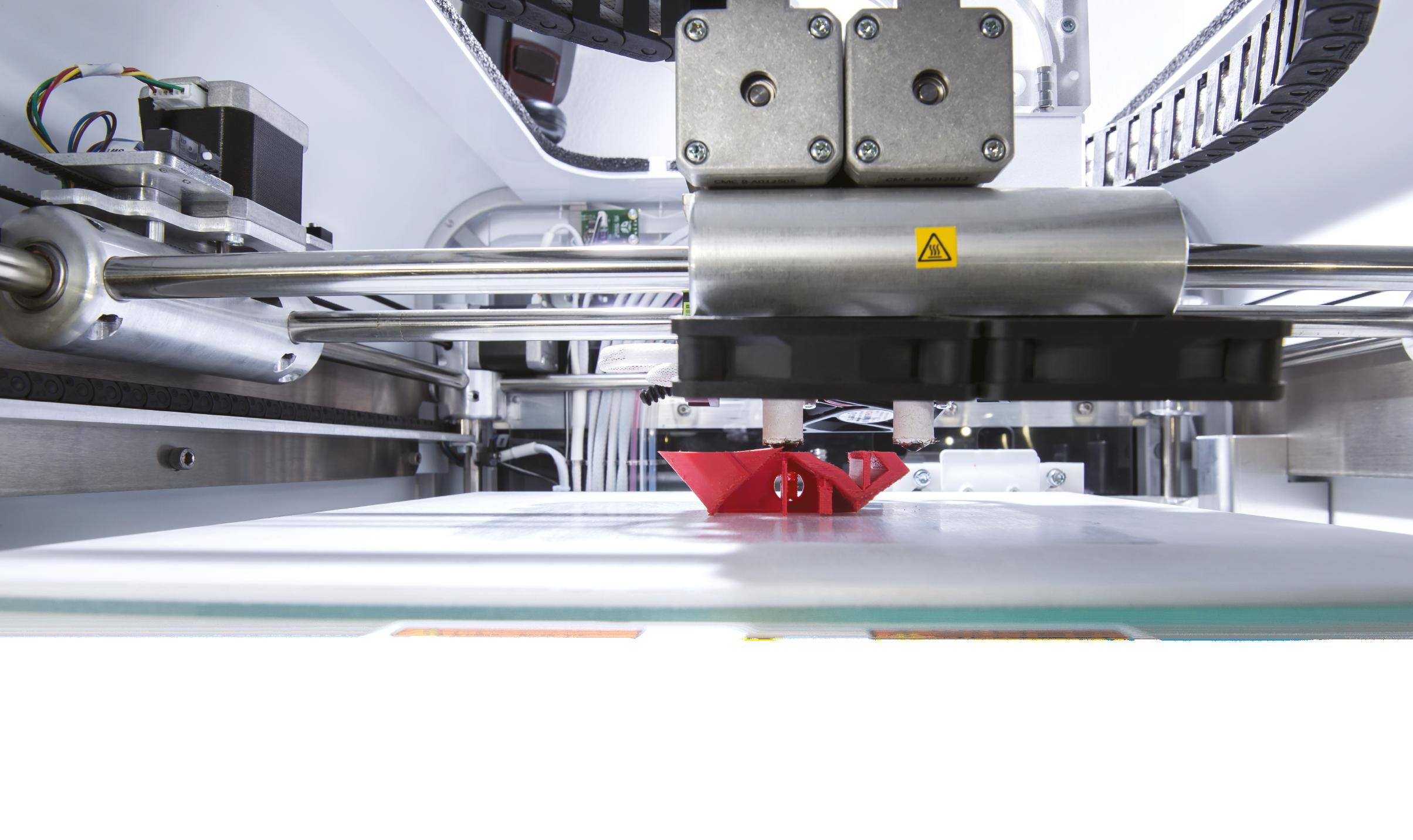
Xeikon sees environmental responsibility not only in products but also in its own operations.
Mertens pointed out that making sustainable choices in product design and development is impor tant, but so is energy efficiency in manufacturing.
The Xeikon toner plant has been working on
green energy for more than five years. The aim is to monitor and maintain a small carbon footprint across operations, including travel and commuting.
As insecurity lingers, environmental consider ations become ever more pressing, and automation becomes more important.
“The commitment to digital production printing is a perfect step for printers to mitigate supply and cost risks and set the stage for staying ahead of the competition in 2023,” Vandagriff said. “As print runs continue to decline, publishing applications such as magazines, catalogs and newspapers that were pre viously beyond the reach of the technology, are now increasingly being considered for digital printing.”
“It’s a challenging climate, but Ricoh expects sig nificant growth in digital print volumes,” de Ridder said. “Changing market conditions and require ments will drive increased demand for shorter print runs, as well as for mass customization and datadriven applications, with less waste and environ mental impact as positive consequences.
“There will be no escaping the pressure to deliver all this cost efficiently, and so we expect that inkjet will be increasingly deployed.”
There is consensus that the rapid progress in inkjet will not stop investments in EP technology. Canon is investing in all technologies. There is room for toner and inkjet, and forecasts show that the volume is there – even for monochrome.

Xeikon will continue to develop applica tion-fit technologies with a strong focus on
“customer-driven innovation,” UV inkjet for labels, dry toner for commercial print and labels, waterbased inkjet for corrugated box printing and the digitization of processes in production.
Fujifilm’s GC Business Strategy unit finds that the launch of a new continuous color inkjet machine this year was a remarkable example that Fujifilm will keep developing new technologies according to the strength of inkjet and electrophotography.
In 2023, we will (hopefully) see the return of the global trade shows, as a launchpad for new devices.
Kicking off the year is Hunkeler Innovationdays in February 2023 – the landmark show for continu ous feed printing. It is likely that most vendors have new launches at this event.
While drupa is still a year out, Interpack in May 2023 would be an excellent springboard to put new packaging presses into the spotlight.
In September, Labelexpo Europe is another event to time presses for, on this occasion, label printers.
The latest drupa global trends report expects a noticeable upswing in investment activity by print ing companies, following years of lower spending. Digital presses are on top of the buying list.
Vandagriff is confident about the opportunities.
“It’s clear that the print industry has reached the tipping point for the adoption of digital production printing,” he said. “Ignoring it is not an option. Smart printers will recognize the need to change, embrace digital print technology to mitigate risks, and set them selves up for success in 2023 and the years beyond.” ●
In 2023, we will (hopefully) see the return of the global trade shows, as a launchpad for new devices.






























































































































 By Trish Witkowski
By Trish Witkowski





















I’ve covered the finishing segment for years, and the speed at which the category is advancing is really quite shocking. There’s so much going on right now that it’s hard to distill it down to just the key highlights, but I’ll do my best for you. The overwhelming theme for technology in fin ishing is the streamlining of tasks to reduce touch points and speed up the process/accuracy/security. Logically, speed is a requirement given that faster and faster equipment placed upstream in production could mean a bottleneck in finishing. However, one of the biggest drivers for combined tasks and auto mation in finishing is the removal of human labor—a crisis that has been sped up by higher costs of labor, fewer skilled workers and increased competition, as well as the cost of errors at the finishing stage. With the supply chain issues and paper and envelope shortages of recent years, there is absolutely no room or tolerance for error. Whereas in the past, faster, more automated finishing equip ment may have been slow to replace legacy finish ing machines that still did their job—a “nice to have” if you could afford the upgrade—in today’s environ ment, automation has become an essential investment for a host of reasons.
In addition to streamlined process automation, other trends in finishing include the ability to accommodate larger sheet sizes, a continued focus on value-added print and embellishments, decentralized envelope production, machine task flexibil ity and robotic assistance in the bindery.
And the equipment manufacturers have really come through with the goods. Fall 2022 was filled with exciting launches given the return of PRINTING United, and many kept their most excit ing advancements under wraps for launch on the show floor.
I can’t possibly share all of the announcements in a short article, so consider this a sneak preview, and there will be a lot more to see in my webinar.


The Hunkeler DocuTrim Digital Sheet Finishing System made its North American debut at PRINTING United. The DocuTrim is a modular, multifunctional sheet processing system that can trim, cut, perforate and stack sheets up to 20.47" x 20.47." The DocuTrim was specially designed for maximizing the productivity of short- or single-run applications, and it can be run at speeds of up to
The modular, multifunctional Hunkeler DocuTrim Digital Sheet Finishing System.

11,500 sheets per hour.

























































































Research conducted by W+D determined that 80% of e-commerce shipments weigh less than 4 pounds. The future is about doing more with less, and the W+D 449 E-commerce Mailer Bag Machine has taken the multiple production steps that are currently being used to make e-commerce mailers, and has combined them into one faster, easier-to-operate machine.

Rollem’s Mailstream is a fully automated fin ishing system designed for streamlining processes on mid to high volumes of direct mail products. The machine can accomplish many processes in one pass, including four-sided press sheet trimming, slit ting, scoring, perforating (T + L), cold or hot glue, and folding. It is ideal for multi-panel direct mailers, postcards and transactional statements. It is avail able as a self-feeding system or as an In-line solution for most digital presses, UV coaters and laminators.
The Hunkeler/Horizon Roll-to-Stack-toBooklet Solution combines Hunkeler’s Generation 8 unwinding, cutting and stacking modules with the Horizon iCE StitchLiner Mark V Saddlestitcher. This combination solution delivers finished booklets or fully separated offset stacks from a roll. The solu tion offers inline cover feeding and non-stop pro duction on a wide range of paper stocks. Variable
Horizon’s new Robot Arm feeding book blocks from the Horizon HOF-400 Sheet Feeder into the Horizon BQ-270V Perfect Binder.






















































































sheet-count booklets can be produced using barcode scanning or mark reading.
BookReady from Tecnau, offers the conversion of SRA3+ (~13" x 19") sheet sizes printed in two-up and four-up into final size book blocks such as A4 and A5. The machine changes applications on-thefly without any manual intervention at full printing speed, enabling book printers to manage short runs and book-on-demand with exact page separation and no guillotine processing. With an optional automatic 90-degree turning station, book blocks are neatly cut, stacked, offset separated and delivered to a belt conveyor ready for binding.
Duplo went all-in on larger sheet sizes, launch ing several new, B2-format machines at PRINTING United. The DuSense DDC-8000 B2 Raised Spot UV Coater offers a fully automated digital spot UV solution with cold foil capabilities. In the cutting category, they released the DC-746 B2 Slitter/ Cutter/Creaser, and the DSM-1000 B2 Platen Die Cutter—both designed to convert oversized B2 sheets with ease for multiple-up jobs, packaging and other applications. They also launched the Ultra B2 UV/Aqueous Coater, a budget-friendly and easy-touse coating system for direct mail and brochures.
Visitors to PRINTING United were treated to a special demonstration of Horizon’s new Robot Arm feeding book blocks from the Horizon HOF-400 Sheet Feeder into the popular Horizon BQ-270V Perfect Binder. Horizon’s Robot Arm is designed to reduce the cost of human labor while increasing efficiency. Automating simple and time-consuming tasks with robotic technol ogy also allows experienced operators to focus on meaningful work for greater productivity and job satisfaction.









































































































































The new W+D BB1000 is the first all-in-one envelope converter and inserter totally inte grated together and designed to handle datadriven 1:1 digitally printed envelopes, with 1:1 content that allows one single workflow—signifi cantly speeding up the time-to-mailbox for mar keters to get complete letter mail package into the mail stream. This machine was designed to be able to react at the speed of
real envelopes. The 410 KC can also convert 1:1 personalized envelopes with a new intelligence package that will allow commingled printing to be monitored.
Roll2Mail (R2M) from CTP Solutions offers endless flexibility to convert your continuous inkjet roll output into dynamic variable full color “snap-pack” self-mailers. Solutions are secure and tamper proof, can be inline or nearline, and can even include floating inserts and return envelopes. The R2M high-speed finishing equipment runs at the speed of the press and can print, cut, fold and seal 8.5 x 11 sheets (2-wide) at speeds of up to 80,000/hour.
With the GF-500 Gauze Feeder and ESF-1000 End Sheet Feeder, the BQ-500 Perfect Binder from Horizon can seamlessly switch between automated soft cover book production and book block preparation for case binding.
making a postcard or self-mailer but with the security, importance and completeness of messaging that only a letter mail package can afford.
W+D has refined the 410 Easy Enveloper, launching the W+D 410KC for more produc tion flexibility and ease of use in the produc tion of data-driven personalized mail. New features include the ability to run in both the blank fed or web fed mode, the ability to print flexo or run pre-printed litho or inkjet blanks or web, and the ability to make self-mailers in addition to
The W+D BB1000 is a complete direct mail production finishing + inserting system for inkjet print.
Gauze width and length on the GF-500 are set up easily according to book block information from the binder for consistency and minimal waste. The ESF-1000 adds folded end sheets to the book block, and it can accept loose sheet, folded signature, glued book blocks or sewn book blocks. ●

VIRTUA



























































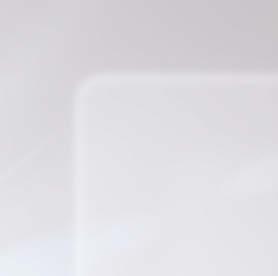


















































































Walk into most modern print service providers (PSPs), and something astonish ing is happening — complex, custom manufacturing.
Printers are really good at printing stuff. Putting ink or toner on a vast range of substrates is something PSPs do daily.

The process is getting a bit easier every year thanks to the automation and intelligence that print manufacturers are embedding into their printing equipment. The technology enables calibration, registration and color management at high levels by operators at all proficiency levels, including those without specialist training.
What is not getting any easier are the operational processes required before and after printing. Capturing the customer’s request is like running blindfolded through a minefield. Critical infor mation needed to quote and produce the orders arrives haphazardly, out of order or not at all.
Heroic customer support representatives spend hours tracking down the essential details from the sales team, clients and partners, while the scheduling team is making constant adjustments in support of changing deadlines.
Once the order becomes a job, more heavy lifting is required by additional staff to merge the custom er’s artwork and data files with the job ticket before pushing it into your print production workflow.
Once the files are prepared for production, the next pause begins as the production team waits for the customer’s approval.
After customer approval, printing can take
minutes, hours or days depending on the nature of the job, the required technology and the run length.
Printed rolls and pallets become the next bottleneck. They stack up in the finishing department, where the equipment mix is often older and not automated.
The bottlenecks and costs are usually masked by the lack of tracking and review to identify the root causes and potential remedies, because the work miraculously makes it out the door to meet the customer deadlines.
The final time-sucking hurdle is reconciling the production ticket so accounting can send the customer an invoice. But it may not accurately reflect the costs to produce the job. If there is no time tracking on the approval cycles, or tracking of reprint costs and customer change requests, there is no way to know the actual cost or profit.
Job onboarding, proofing and approval, and invoicing are the three most consistent problem areas found during workflow assessments for every type of print service provider. Each area requires a mix of streamlined processes and soft ware for optimization.
Top Fix: Optimize your job onboarding process with web-to-print or job onboarding portals. Industry surveys point to job onboarding as fragmented, not standardized, and adding cost to production. Building an efficient, automated onboard ing process is essential.
Job onboarding is where profit leaks from the bottom line most dramatically. It must capture the customer’s specifications and files needed to accu rately produce the work once it becomes an active job.
Use the 80/20 rule and focus on the type of applications that represent 80% of your print volume. Create standards for capturing that infor mation regardless of how the order originates.
Consider a web-to-print or portal solution, and have the sales team and customers use it to log jobs and communicate. If you already have tools that can streamline job onboarding, like your web-to-print system or an online portal attached to your print MIS that can be used by sales and internal staff members, create policies that require their use.

Top Fix: Standardize on electronic proof ing and approval integrated into your production
Job onboarding, proofing and approval, and invoicing are the three most consistent problem areas found during workflow assessments.
dashboard. Keeping the process visible is the best way to keep clients engaged. Consider adding waiting fees for delayed responses.
Electronic proofing is acceptable to many cus tomers who are primarily concerned with the content. It is also becoming more standard for design agencies and brand-focused print buyers. Switching from hard copy to electronic proofing improves communication with the customer and speeds up approvals, so the work moves faster to the required printing and finishing (or e-delivery).
There are many solutions in the market, from equipment manufacturers and independent soft ware providers, that allow customers to upload, preflight and approve their files, then push them to the downstream workflow. Talk to your current workflow vendors to identify their options. If you belong to a networking group or professional asso ciation, reach out to your peers to see what solu tions have worked for them.
Top Fix: Review your customer agreements to ensure you can invoice for customer change requests and customer delays. Review your internal processes to ensure every data point is captured for timely, accurate invoicing.
PSPs realize the importance of capturing produc tion costs and passing any applicable charges back to the customer, but knowing the importance and ensuring it gets done are not always the same things.
Too often, those chargebacks are written by an operator on a physical job ticket and must be reconciled in the accounting department. Sometimes salespeople wander through the process and write in discounts because they believe the customer is entitled.
These manual processes are error-prone and add time to ensure accuracy before the bill can be sent to the customer. Most print MIS solutions can streamline the process, typically called change order management, for charges to be captured and automatically added to the invoice.
PSPs have outsourced areas of production for years to trade printers. Sometimes it makes sense to outsource based on capacity and schedule. Other times, outsourcing is the best way to get access to grand format printing, embellishments or perfect binding, because you may not have those capabilities.
Begin with your core production pro cesses to find the areas with the best ROI. Remember that buying software today has many more options than just a few years ago.
The software required to run your busi ness is increasingly available in a soft ware-as-a-service (SaaS) option. Instead of your team administering and maintain ing the underlying hardware, updates and security, those processes are outsourced
to the provider.
The underlying hosting infrastructure of SaaS solutions is commonly Amazon Web Services, Microsoft Azure or Google Cloud Platform. Without going in-depth on the benefits and fea tures of those services, PSPs should factor the platform into any purchasing decisions.
The next six months should see a series of announcements from the software divisions of the major hardware vendors and the diverse array of dedicated independent software vendors who serve this space. For most PSPs, the place to start is with an assessment of your environment.

Talk to the customer service and produc tion teams to understand where they spend the most time. Identify the framework used by sales and customer service to move a job from a cus tomer request to production. Even if you don’t have data on the average time for approvals, talk to the team and get their views. Talk to the backoffice team about the accuracy of the invoice data and how often they must issue credits for incorrect billing.
Use this time to prepare for the uncertainty expected in the coming months. Lower your operational costs and double down on your core business offerings. Focus on your expertise, improve your operations, and outsource where possible to provide a solid foundation that responds to the changing market and gives you the foundation to succeed next year. ●
Pat McGrew has more than three decades as an evangelist for technology in communication. She is an author and regular writer in the industry trade press.

Ryan McAbee is the principal at Pixel Dot Consulting, a firm that partners with companies in the production printing industry to ‘Elevate print through tech.’ Ryan has spent over 20 years immersed in the technology that powers print, working with vendors and providers.

BookBaby is a publishing services provider for independent, small and selfpublishers. The company is celebrating its 10-year anniversary in 2022.

WhatTheyThink: I guess we should really start with what is Book Baby?
James Foley: I like to describe BookBaby as a full-service pub lishing services company. We do everything a publisher needs to bring a book to the marketplace. Editing services, book design, e-book conversion and all-digital books.

We have a 150,000 square foot book printing facility in Pennsauken, N.J., just outside of Philadelphia, where we do softcover book printing, color book printing, hardcovers, black-and-white— you name it. We do bulk printing—anything from 25 books up to hundreds and 10s of thousands. And we also do single book print-on-demand to support online retail sales. We’ll print one book, put it in a mailer, and ship it out.
We also operate our own bookstore called the BookBaby Bookshop, which is positioned as a fairtrade retail store and the most author-friendly book store on the internet. The idea with the concept is that we want to fill the void in the retail space where there’s a real champion for independent books.
We just focus on the wonderful authors who produce these quality indie books that we love. We pay the authors the lion’s share of the money when the books sell. Fifty percent royalty on print and 85% royalty on e-books, and that’s right off the retail price that the author/publisher sets for themselves.
WTT: There’s another company called Independent Publishers Group (IPG). Do they compete with you or do you work with them?
JF: Independent Publishers Group is widely known in the publishing business and close partners with BookBaby. They are a primary wholesaler of the BookBaby catalog. We use IPG to get to many retail outlets. They were our first wholesale partner for printed books. We have direct relationships with almost all global outlets for e-books that we deal with directly. Our catalog is avail able through most wholesale net works that are out there. We value our partnership with IPG because they share our indie ethos.
WTT: According to some Smithers data, book production is expected to grow about 17% between now and 2027. Are you seeing the same kinds of growth forecasts?
JF: We are and we’re rapidly adding capacity. We just crossed this year the 100,000 mark for titles in our catalog, and we grew 51% last year. The pandemic year we grew 38%. So we are forecasting that kind of growth moving forward. There are more people coming into the market than ever who want to get their content out to the world, so we see no signs of the indie publishing market softening.
WTT: Are there any specific trends that you’re seeing, whether it’s the type of people who are publishing now or the subject matter?
JF: People think that what we do is service mostly genre fiction authors, and that’s not really the truth. They’re a significant population of what we do, but there’s a lot of nonfiction being created. The children’s book market is huge. Cookbooks went crazy during the pandemic—all kinds of people are making cookbooks.
Millennials are the first generation that grew up with blogs. A lot of people had blogs as part of their
Davidexperience growing up, and they were trained to write and share their opinions and perspectives. People are now maturing and they’re publishing their works. You know, one of our bestselling books last year was a comedian who did “Fergamerican National Anthem,” a book based on Fergie. They sold it exclusively through us, and it sold thousands of copies overnight just from a video popular on YouTube. This generation creates and consumes content in greater volumes than ever before. These are exciting times in indie publishing.
In addition, we offer support for social media adver tising on Facebook, Instagram, LinkedIn, and we are starting to experiment with Tik Tok too.
We are a 75-year-old tech company that’s been operating in the independent music space. We invented the model back in 1949 where independent musicians came to a company called Disc Makers, and we started making complete record packages. We really invented the complete selfpublishing solution for independent musicians— back then, largely jazz musicians from Philadelphia and the New York area. And then 50 years later we purchased a digital music distribution company called CD Baby, which we sold a few years ago, but CD Baby was the birth of BookBaby and our entry into the digital publishing world.
WTT: Are you mostly or all digital printing?

WTT: So you’ll take the copy and do any editing if required and I assume composition?
JF: We do offer line editing, copy editing and then proofreading. We have authors who’ve had long careers of publishing with top publishing houses and now they’re independent and putting out their own titles. They usually use our copy editing and proof reading services. And then we have newbie authors who are publishing their first books and they need some help and they’ll go with a more robust line editing. You can have as many rounds as you want with that service until you’re happy.
WTT: What kind of promotion do you do?
JF: We operate an internal ad agency. We do all the digital marketing. We support network display adver tising through all the exchanges online. Depending on what kind of author you are, we look at your best buyer personas. And then we identify where those targets hang out online. We do our keyword research and outlet research and all that science. Maybe your audience hangs out at Home and Garden, so we’re going to put display ads on that website. You name it.
JF: This year, we just sold off our last offset presses. We’re 100% digital now. We have 10 digital presses. We can deliver a published product that rivals any thing coming out of any publishing house. We have a fleet of HP Indigo presses—we were one of the early adopters of the Indigo technology. This year, we pur chased two Xeikon rollfed presses. We partnered with Xeikon because of the quality of the printing. We have multiple binding lines for perfect binding and case binding too. We have three case binding lines, saddlestitching, coating, lamination, you name it.
WTT: How many employees do you have?
JF: We have a staff of around 400 people now. We have a robust and diverse network of editors because we must service all these different genres. On the front end, we have a team of professional graphic designers and digital e-book converters. We have a distribution team who handles the distribution network and all the relationships there. And we have an internal advertising agency.
WTT: As an author, I can go onto a dashboard and see how I’m trending, where I’m trending…
JF: It’s amazing. You can see what countries, what cities, your buyers are in. You can see how much traffic you’re getting to your page, how much is converting, where they’re coming from, what device they’re on, if they’re on a desktop or mobile device, these kinds of things that you use to analyze your marketing effectiveness. BookBaby is the
We have authors who are very successful selling books with us —and all these tools help you stay engaged with your community. You can’t not have these tools anymore.
engine that authors and publishers run their publishing business on. In today’s world you must have this data. You can’t be in business without it.
WTT: So how did you get involved in this?
JF: I’ve been with the company for 23 years, and I’ve been a customer of the company for many more years. I became a customer of Disc Makers because I’m a musician. I still make records. I have a band, and we just released a new EP last week on Bandcamp. Our band is called Canadian Invasion. I’m a writer as well.
I started with the company back in my early 20s. I had several jobs: I was director of procurement for many years, which was the role I had when these technology changes in book publishing really started to catch on.
At the time, we were the biggest aggregator of digital music for Apple. Apple was coming out with the iPad, and we had a great relationship. Conversations started, where they said, “Well, we’re going to have this iPad and we want to have content for it. We would love to service the independent writing community just like we do in the independent music community, but we don’t have a service partner like we do with you in that space.”

David Zwang interviews Joe Matthews, CEO of Independent Publishers Group. IPG is a 50-year-old, family-owned book distribution business, the first to bring an alliance of small publishers together to act like one big publisher.

So we got together and we said we’re going to start making e-books and delivering them to Apple. That was the first thing BookBaby did.
Then on the heels of that, authors said, “Can you do our book covers, too?” And we said, of course we do that. Then people started asking for editing ser vices, so we built a network for that. We had a print shop, and people started asking us to print their books. I started learning about book binding because we didn’t do any casebound stuff for the music busi ness. So we incrementally built it from scratch.
Around 2015 is when we had a complete solu tion: the retail store, the book printing, digital books, editing, design, reporting, marketing. And now as we move forward, the next year’s all about beefing up our printing capacity, investing in our bookstore, and we’re really investing in technology, the analytics and the marketing and advertising that authors need.
WTT: I can see where the analytics alone are going to help drive volumes, especially in today’s day and age where it’s all about how many clicks can you get.
JF: We have authors who are very successful selling books with us —and all these tools help you stay engaged with your community. You can’t not have these tools anymore. ●
IPG also operates two publishing companies: Chicago Review Press, which publishes adult nonfiction, and Triumph Books, which publishes sports titles. They recently added a print manufacturing facility which has become their biggest profit center.
To view video scan the QR code of visit: https://whattheythink.com/r/111705.
PRINTING United Expo returned to Las Vegas to present a stunning carnival of printing technology, consumables, software and ground-breaking innovations.
The show offers technology in action alongside the latest trends on full display from wideformat to apparel and everything in between, and pro vides a good basis for our 2023 technology outlook.
The title sponsor, HP, chose PRINTING United Expo to announce new solutions to help print service providers (PSPs) meet high levels of demand, optimise work processes and grow their businesses by delivering innovative applications.
HP showcased their new 3.2m (126-in) wide HP Latex 2700 printers, which take production effi ciency to the next level, offering vivid colors at up to 89 m2/hr (958 ft²/hr) via symmetrical double printheads, which come equipped with automatic printhead cleaning technology.

HP also launched their new Professional Print Service Plans, which are designed to enable


business agility, maximize uptime and productivity, and to provide learning opportunities and support.
Print service providers have a choice of two dif ferent HP Professional Print Service Plans – Basic and Plus – with each containing a portfolio of service and software solutions tailored to business needs.
The diamond sponsor, Kornit Digital, unveiled its “Impact Report” for 2021, highlighting progress made against their goals and further expanding their commitment to a long-term strategy designed to transform the world of fashion and textiles into one that is more sustainable.
In pride of place at the Kornit stand was the Atlas POLY MAX, which is a sustainable and affordable solution for printing directly onto polyester. With the launch of Kornit’s ground-breaking MAX technology, many capabilities that seemed out of
In pride of place at the Kornit stand was the Atlas POLY MAX, which is a sustainable and affordable solution for printing directly onto polyester.
reach are now possible, with many new creative applications enabled by Kornit MAX technology yet to be explored.
In addition to design elements, the Kornit systems can handle different production volumes, including short runs and one-offs. The result is a flexible production system, catering to the needs of multiple target audiences, further broadening the print service provider’s customer base.
Platinum sponsor Epson showcased its full line of professional printing solutions, including its three Printing United Alliance 2022 Pinnacle Product Awards winners.
The new SureColor P8570D and SureColor F6470H earned recognitions in Roll-to-Roll Aqueous (Under 80 inches), and Roll-to-Roll Dye-Sublimation on Metal, categories respectfully. Additionally, the SureColor F10070 received recognition for the third year in a row in the Roll-to-Roll Dye-Sublimation on Textile ($50K-$100K) category.


Platinum sponsor Fujifilm announced its entry into the high-end wide format hybrid market with the unveiling of the new Acuity Ultra Hybrid LED printer.
The Acuity Ultra Hybrid LED expertly handles
Not only has it been rebranded with Agfa’s characteristic Warm Red color, but it also ran on Agfa’s dedicated new inkjet ink. Agfa also demonstrated the printer’s newly developed high-throughput, high-quality speed modes. The Inca Onset has been pushing the boundaries of what is possible in print for the X3 HS is capable of 24/7 printing at a production speed of 15,600 ft²/h.
EFI, also a Platinum sponsor, showcased Fiery Impress, the new, easy-to-implement, turnkey DFE solution for inkjet printer manufacturers that offers high-speed productivity, high automation and comprehensive color management.
Advanced digital front end (DFE) and print workflow solutions from Fiery, a business unit of Electronics For Imaging, Inc., demonstrated the unstoppable innovation needed to help customers maximize productivity and profitability in their digital printing operations.
Durst Group, a Platinum sponsor, announced an extensive line-up of technology where three printers from the Durst P5 portfolio, never before seen at PRINTING United Expo, were showcased at the exhibit.
First, the Durst P5 500, a 5.25m roll-toroll printer, brought “Super-wide format” to the P5 portfolio, allowing efficient and unat tended production.
Next, the P5 TEX iSub, a dye sub printer for soft signage and fabrics printing, was also showcased. This dye-sublimation printer with inline fixation offers a 1-step direct-tofabrics printing process.
Third, the all-in-one Durst hybrid P5 350 HS was exhibited with Double 4 technology. The Durst P5 Double 4 (D4) technology maximizes the productivity of the P5 UV series printing systems through the implementation of a double CMYK color configuration.
both rigid and flexible media, all-in-one platform, delivering an extremely versatile solution with maximum speeds of up to 2,346 ft²/hr. (roll-to-roll) and resolution of up to 1200 x 1200 dpi.
Platinum sponsor Agfa presented for the first time, an Inca Onset high-speed printer in its booth, the super-fast X3 HS.
In the coming technology field, STS Inks, a global leader in the wide format, industrial and household inkjet markets, launched its robust DTF series printers.
Built with advanced Direct-to-Film (DTF) printing capabilities, the Japanese-made 1682D 64” DTF Printer provides a staggered dual-head design that
Fujifilm announced its entry into the high-end wide format hybrid market with the unveiling of the new Acuity Ultra Hybrid LED printer.The P5 TEX iSub, a dye sub printer for soft signage and fabrics printing, has inline fixation and offers a 1-step direct-to-fabrics printing process.

provides ultra-fast print speeds and is coupled with the STS 48” Automatic shaker for increased workflows and processing speeds.
STS also revealed the new features of the exclusive STS Inks XPD-724D coming in January 2023. With enhanced user-friendly operation and mainte nance, the debut will offer high-quality production and high-quality output, alongside the enhanced performance characteristics that are associated with a built-in white ink circulation. The system allows for the free unobstructed flow of ink directly to the print head providing optimal results.
Both the 1682D and upcoming XPD-724D pair with STS’s DTF ink, which offers users excellent color gamut and outstanding durability.
Finally, SwissQprint presented the second genera tion of its Karibu roll-to-roll printer. By means of the latest print head technology, the Swiss manufacturer is taking UV roll-to-roll printing quality to a new level.
Karibu 2, the dedicated roll-to-roll printer from SwissQprint, uses the latest print head technology. It achieves up to 1350 dpi resolution. The Karibu 2 delivers top quality even at high output. The machine accommodates rolls up to 3.4 metres wide and prints using UV inks that are flexible, NVC-free and Greenguard Gold certified.
Elsewhere, CorelDRAW Graphics Suite exhibited their recently updated budget-friendly subscriptionbased software, which provides a fully loaded pro fessional design toolkit for delivering breathtaking vector illustration, layout, photo editing and typogra phy projects with total efficiency.
Also on the software front, Print Factory launched their new revised dashboard, which provides a consolidated view of all con nected devices (printers and cutters) across all production sites, as well as job information,
including nests and processes.
In addition to displaying pending jobs based on delivery deadlines, the dashboard includes a “Health Check” to inform the production team of potential problems before a disruption occurs.
Onyx Graphics showcased color automation tools using the new ONYX Color Reference Library, available exclusively in ONYX 22. This latest version of industry-leading ONYX software was released globally in July, providing a new drag-anddrop user experience with easy-to-use tools for everyday automation.
And finally in software, OnPrintShop, the most preferred Web-to-Print Solution, launched its Enhanced Partnership solution - a scalable and flexible framework specially designed to offer reseller/franchisee stores, the ability to develop vendor API, give complete control over the entire reseller/franchisee network, and consistently deliver white label shipping.


Trader printer/franchisee can set up print products centrally, and resellers can easily mark up. Personalized reseller stores and franchisee stores can be created in minutes, and marketing activities can be effectively managed.
The innovation demonstrated at PRINTING United Expo provided a peek into what we can expect to see as 2023 rolls out: faster, more func tional printers; more advanced software; and a continuing digital transformation in the textiles and apparel industry. ●
Debbie McKeegan is the CEO of TexIntel.
As a multi-disciplinary creative and renowned digital print pioneer, she holds over 25 years’ experience within the Textile manufacturing industry.




Career paths rarely follow a road map with signs pointing the way, and it can often take some time to find the perfect path to a rewarding career. Sometimes, however, signs do point the way, especially if you choose a job in the signage industry.
The visual communications industry, covering $37.5 billion in economic impact, employs over 200,000 people in America. An industry that’s attractive to creatives, it offers a long-term, rewarding career with growth potential. This year, for Sign Manufacturing Day, FASTSIGNS celebrated the holiday by showcasing the longevity and excitement of a career in the industry.

Carmen Ruiz, franchisee at FASTSIGNS of Daytona Beach, Fla., began her career in the sign industry outside of the FASTSIGNS network. After high school graduation, she eventually joined FASTSIGNS of Apopka, Fla. in 2005. She briefly diverged from the path and went to work for the Apopka Chamber of Commerce with the longest-serving mayor in the U.S. for a time, but she missed FASTSIGNS.
“I love signs, and I love people,” she said. “The sign industry gives me the opportunity to get to know people.”
Several years later, she returned to FASTSIGNS of Apopka as the sales and marketing manager. In 2017, the opportunity to purchase FASTSIGNS of Daytona Beach arose, and she jumped.
Ruiz and her team experience success because of the relationships they build with their clients and com munity. She has worked to highlight their capabil ities within the market. She and her team strive to be wise stewards, inten tional in their projects, and they work strategically with their time, energy and resources.

“My role as franchisee provides me the opportunity to solve customer challenges, and I love when customers get excited because we provided an awesome solution for them,” Ruiz said.
“My business also gives me the flexibility to make an impact in the community that I love.”
In the FASTSIGNS network, franchisees are encouraged to leverage their creativity and businesses to engage directly with their customer base, build local relationships, and be the face of their business in the community.
Carmen acknowledges that transformation is at the heart of the sign industry, and she and her team strive to embody that concept and transform their community. They try to focus on “work that matters” to show that they are an engaged community partner and are providing a good example of social responsibility. Her team is involved in several philanthropic activities throughout the year.
An interesting career path led Maria del Fierro to employment in the custom sign and visual solutions industry.
Now a graphic design/production manager and master of many skills at FASTSIGNS of San Diego, Calif. - Mira Mesa, del Fierro initially went into the medical field after graduating from the Art Institute of California - San Diego. She quickly realized she did not want to be in the medical field, and the Art Institute helped her find her position at FASTSIGNS.
In almost eight years since joining FASTSIGNS, her role has grown beyond graphic design. She is crosstrained in the different roles at FASTSIGNS from pro duction to installation, and she is able to do everything from vehicle wraps to window graphics and more.


“There’s not a dull moment at FASTSIGNS,” del Fierro said. “I love being in the center.”
With her keen eye for design and skills to build, she is an incredible asset at her center, especially when it comes to making things happen for customers.
“If there’s a will, there’s a way,” she said. “Try to think of everything like a puzzle or map. Find layers and see how you might build it out. If you have a big idea, just go for it. You’ll hit bumps, but don’t forget your goal. Keep that in mind as you’re working to complete the project.”
The sign industry, and specifically FASTSIGNS, is a place where collaboration is encouraged and creativity and innovation are fueled. Local centers are made up of people who consult, design, engineer, produce and install. In the sign industry, every day is truly unique and presents exciting opportunities, including new ways to use talent and grow skills.
By utilizing cutting-edge technology, sign experts transform ideas into custom signs and visual solutions that make an impact.
At the end of the day, signs help businesses and organizations visually communicate their message and ultimately make communities more organized, connected and interesting. ●
The Foil & Specialty Effects Association (FSEA) serves two distinct purposes for the printing and finishing industry.
First, it provides benefits for its members who are involved in the production of printed materials that include specialty effects, such as decorative foils, UV coatings and laminates.
Secondly, FSEA focuses on educating brand owners on the benefits of specialty embellishment as it pertains to folding cartons, labels, direct mail and greeting cards.
For its members, FSEA strengthens the industry through the sponsorship of events, webinars, statistical surveys, reference tools, an association maga zine (PostPress) and its website.
FSEA recently sponsored the Amplify Print event where FSEA and its partner, the Association of Print Technologies (APTech), brought together suppliers of finishing and embellishment equipment and products to connect with printers, print finish ing and embellishment producers, brand owners and designers. This created a networking oppor tunity for everyone involved in the production of a printed piece. Amplify was very well received by the nearly 1,000 attendees, and the next Amplify event is scheduled for 2024.
Recently, FSEA launched the Digital Embellishment Alliance (DEA), created as an educa tion and communication opportunity surrounding the growing digital embellishment segment of the printing industry.
DEA will provide educational programming and membership benefits, including special programming at FSEA events, standardization initiatives, designer outreach, trend analysis and brand education. A website will be dedicated to DEA to provide information and resources on digital embellishment technology.
The Foil Cheat Sheet explains the different techniques available for creating metallic foil finishes.
With the continued emphasis on sustainability, FSEA has commissioned a study on the repulpability of paper decorated with transfer foils – produced in conjunction with the Georgia Tech Renewable
The study demonstrates that transfer foil decorated paper and board do not create problems in the recyclability/repulpability of paper and/or board in a common repulping process.
In addition to that study, FSEA also issued a press release on the negligible amount of metal (aluminum) that is present in transfer foils. Recyclability of decorated paper and board will continue to be a focus of the association.
To increase awareness of foil decorating techniques, FSEA has produced the Foil Cheat Sheet, in cooperation with PaperSpecs (an online platform developed to communicate easy-to-understand tips and tricks on print and paper technologies).

The Foil Cheat Sheet is an excellent source explaining the different techniques available for creating metallic foil finishes. From hot and cold foil to toner-based and varnish-based digital foiling, the guide describes each technique and provides the advantages and disadvantages of each. The coilbound guide includes decorative samples of the dif ferent metallic processes and a fold-out table that summarizes the process, colors available, overprint ability, best paper stocks and suggested print runs.
For more information on FSEA and/or the new Digital Embellishment Alliance, visit www.fsea.com or contact Jeff Peterson, FSEA executive director, at jeff@fsea.com ●
Ienjoy Christmas cards. I send business Christmas cards to all of my clients, many of my vendors, and about a hundred or so personal cards to my friends, relatives and neighbors.
After I wrote a column a couple of years ago about my love of Christmas cards, I snapped this photo of all the cards I received at home, taped up in my front hall, just to show that I not only send lots of cards, but I receive them as well.

I’ve been sending Christmas cards my entire life, so I’ve learned a thing or two about them, and I’m going to share some tips with you, dear reader.
First off, don’t get caught up in political correctness. In my experience, everyone enjoys receiving a card, and everyone understands that the Christmas season is a huge holiday in the United States (and in fact all of North and South America.) I send cards to friends and clients of all faiths, or no faith at all. Send a card to anyone to whom you wish to offer a sincere greeting.
This applies to other cultures as well. I send Christmas greeting cards to friends on many continents including countries where Christianity is uncommon and Christmas is not generally celebrated. Everyone is happy to receive a greeting in the mail, no matter what the occasion.
Don’t confuse holiday greeting cards with advertising. This is most assuredly not the time to stuff coupons, flyers or press releases in the envelope. That doesn’t mean, however, that you can’t put your logo on the card. I hand sign my personal Christmas cards, but on our corporate cards our logo is the equivalent of a personal signature. After all, the card is not just from the president, salesman or owner; it is from everyone in the company.
If you have a clever artist on staff, whip up your own custom card with Santa’s elves scur rying around the bindery or some such levity.
Now is not the time to show off your mailing prowess. Neatly hand address every
card and use first class holiday stamps.

Lastly, don’t be stingy with holiday cards. Save the expensive gifts for your biggest clients, but everyone deserves a card in the mail. Vendors too. If you have more than one contact within a company, consider sending each a card. Same goes for clients with multiple locations.
Is it too late to get cards out in time for Christmas? No problem; a New Year’s card will also be appreciated.
Whatever the season and whatever your preferred greeting, allow me to wish you a Merry Christmas, from Johnson’s World to your world. ●















